Good lighting is important in any room, but especially in the kitchen. Much depends on how correctly you plan the light here: the convenience of kitchen worries, the mood of the hostess, and even the quality of the cooked dishes.
And if your kitchen also serves as a dining room, you certainly can’t do without hospitable lighting.
How to choose this important element and foresee everything in advance? About this - our detailed guide, including 25 best advice lighting in the kitchen. You will learn:
- why diverse lighting is so important in the kitchen, when and how to plan it;
- what is the difference between local (local) light for the food preparation area and dining table lighting;
- what types of lighting are optimal near work surfaces, and which ones are for cabinets;
- what types of fixtures designers choose for different purposes (spotlights with halogen lamps, LEDs, spotlights, pendant lights, etc.);
- how to choose the right lighting for a small and large kitchen;
- how to ensure sufficient luminous flux to save energy;
- how to make a lighting plan if you are your own designer.
Find out the answers to these questions and more, and see a large collection of examples - 85 photos of examples of lighting in the kitchen.
__________________________
Let's start with the main thing: when to plan lighting?
Best of all - at the time of repair. This is how you can save yourself from additional chasing of walls and ceilings, as well as from regrets about insufficiently comfortable light.
The most important thing is the location (output of wires) and the presence of switches. And with the type of lamp, the power of the lamps and the design of the lampshade, you can decide much later. Including when the repair is already completed.
How to make a lighting scheme in the kitchen for builders (electrician), if you are not a designer and do not repair professionally?
This, of course, is more complicated than the plan of partitions. But a simplified version is better than its complete absence. But the nuances (the ability to do what you want, and the price of the issue) are very desirable to discuss in detail with your electrician. More on this at the end of this guide (section "How to make a kitchen lighting plan").
1-1. Different lighting - for different purposes.
Before planning your lighting, ask yourself: what is your kitchen used for, besides cooking? Coffee in a hurry, leisurely lunches and dinners, meetings with friends - or all together? The more zones in your kitchen, the more light should be. The ideal option is general lighting + as many additional fixtures as needed.
Look at the photos of these kitchens: the lighting in them is planned very well - each for a different purpose. This, by the way, is also practical - in terms of saving electricity without sacrificing light comfort.
1-2. General (top) lighting.
In the kitchen, it is very important to provide a uniform "background" ceiling light. And it is better if such lamps are distributed throughout the kitchen. For general (background) lighting, one 40-60 W luminaire is recommended per square meter. However, there may be more if the ceiling is very high.
1-3. Local (local) lighting.
Even the smallest kitchen needs local lighting. And the more different zones, the more lamps should be. At the same time, their power can be much less than if only general (ceiling) lighting was used. Yes, and less energy will be spent if the light is turned on only where it is needed.
Read more about what zones can be in the kitchen and how to properly light them in the following sections of this guide.
1-4. Decorative light.
Who said that lighting should only be practical? Decorative (accent) light is ideal if you want to rid the kitchen of a purely utilitarian look.
The flow of light here is usually minimal, but a spectacular and fashionable look is guaranteed. The bottom and top of cabinets, shelves in the cupboard - you can choose both a neutral shade of light and color. LEDs work best for this.
__________________________
kitchen work area lighting
The main part of the kitchen and a place where the need for comfortable light can be equated to lighting a desktop. If possible, separate several sections. How larger size kitchens - the greater the scope for variations with the lighting of the working area.
2-1. Take Special attention working surface.
The food preparation area must be ideally lit - this is not so much an aesthetic as a safety requirement. There are two optimal solutions, choose which one seems more convenient to you:
- wall lighting (on the "working apron" between the upper and lower cabinets), photos 1 and 2
- suspended directional, mounted on the ceiling, photos 3 and 4.
2-2. The second level of the ceiling or cornice.
If there is no free space on the wall, but there is (or is planned) a second level of the ceiling, install spotlights in it. They will perfectly cope with two roles - (a) task lighting and (b) general.
2-3. Extractor hood with built-in lights.
Another light option for convenient cooking. Hood lamps do not use much energy, but they are powerful enough to light both the stove and the small space around it.
2-4. Light near the sink.
This technique is not often used, but the hostess is provided with additional comfort. If you decide to make such lighting, be sure to make sure that the lamps are well protected by shades (glass or plastic).
2-5. Light under open shelves.
In the next section, we will talk in detail about lighting around cabinets, including under them. And if there are no hanging cabinets? Or do you want softer illumination of the work area? There is an elegant solution - use shelves with bottom lighting.
As a rule, these are expensive design solutions. And if you want to save money, install LEDs under the shelves, similar to those you will see in the LEDs for cabinets section.
__________________________
kitchen cabinets and lighting
This section is all about the light around kitchen cabinets (under them, inside and above them). And also - about what type of lamps is useful for different purposes.
3-1. Spotlights (halogens) under cabinets.
Here we are talking about furniture spotlights. There is a common misconception that they will cope with the role of "work lighting". This is far from true.
Judge for yourself: the depth of hanging cabinets is usually about 30 cm, the lamps are located in the middle (i.e., approximately at a distance of 18-20 cm from the wall). The depth of the tabletop is 60-65 cm. The stream of light is directed downwards and is slightly scattered. And now count: what part of the countertop will remain unlit? More than 2/3, moreover, on the side where you need it.
Do they make any sense at all? Of course, they are perfect for other purposes:
- night and evening "orienting" lighting (when there is no need to turn on the overhead light or work);
- cozy lighting for preparing simple food and drinks;
- a comfortable light option for those who "wake up" only at breakfast, but quite early (when it is still dark outside the window or just getting light).
3-2. LEDs - for the cooking zone.
Modern professional chefs are sure: when cooking, it is important not only the abundance of light, but also its correct “color temperature”. Simply put, the lighting should not distort the colors of the products.
If you are a gourmet and treat cooking as an art, the best option for you is LED lamps with a high color rendering index.
They are usually mounted under cabinets. And such lamps will successfully replace other types of “working” lighting above the countertop.
3-3. Interior lighting for kitchen cabinets.
Hard-to-reach areas need lighting no less, if not more. In addition, you will not need to turn on the overhead light, just a couple of small bulbs that will light up when the door is opened (special sensor).
The ideal lamp for the inside of the cabinet is small, 10 - 20 watts. If the cabinet is high or the distance between the shelves is large, you can choose furniture lamps with halogen lamps. If the cabinet is small or there are glass shelves, choose overhead spotlights with LEDs. The third option (quite rare) is thin fluorescent tubes.
3-4. Illumination in drawers.
Also very convenient. Miniature lamps are mounted on the walls of the box and turn on automatically when opened - using a motion sensor. Such lamps are durable, consume little energy, which makes them an indispensable assistant to the hostess.
3-5. Mini soffits over cabinets.
This solution is often found in new version kitchens IKEA METHOD. Optimal if you have a lot of cabinets with blind (not glazed) doors. These directional spotlights (mini spotlights) are mounted on the top cornice and illuminate the inside of the cabinets well when you open them.
Do you want to be in touch with us every day? Welcome to our Planet of Inspiration Vkontakte! Check it out, scroll through! Like? Join and get inspired every day!
__________________________
directional local lighting
As a rule, these are “spotlights” - lamps with a narrow stream of light directed to a selected area. Usually they have a conical ceiling (metal or glass) and can be rotated in different directions. This makes them especially convenient for the kitchen, allowing you to illuminate the desired area.
4-1. Ceiling spotlights.
Usually used for general (top) lighting. The most convenient is a module of several soffit lamps on a single base (“ceiling rail”), photos 1 and 2. The lamps can be turned in different directions (the kitchen is illuminated more evenly), but there is only one electrical output (economical in terms of electric costs).
Sometimes there are variations: single spotlights are sometimes hung on the ceiling at different points (photo-4) or several modules with a thin base and small shades - for a large kitchen with high ceilings (photo-3).
4-2. Wall directional light.
This solution is used for directional lighting at a height of 1.50-1.80 m from the floor. In case of successful placement, it can serve as a working light.
4-3. Swivel wall lights that change the angle of inclination.
A rather rare solution in our country, but very popular in Europe. This is a wall-mounted modification of a working lamp with a long adjustable stand. Allows you to illuminate the far section of the table or near. A more compact option is a wall sconce with a swivel base (photo-3).
__________________________
lighting of various additional areas of the kitchen
The number of zones is usually determined by the size of the kitchen. See what lighting designers recommend for different areas.
5-1. Warm light - for the dining area.
If your kitchen also serves as a dining room, take care of warm and cozy lighting above the dining table. Pendant lights are best (one of a pair - according to the size of the table). To prevent the light from hitting your eyes, make sure that there is at least 80 cm between the lamp and the table.
5-2. Pendant lights above the bar.
In addition to a special atmosphere, such lamps can bring a touch of your favorite style to the kitchen. Or emphasize the one that is already there. It is very convenient if the cord of such bar lamps is adjustable in length, allowing you to raise or lower the light relative to the bar counter.
5-3. Don't forget about the kitchen island.
This piece of furniture can fulfill a wide variety of roles, and each requires special lighting. Think about what suits you best: pendant lights, halogen lamps or adjustable wall sconces.
5-4. Light in the closet.
Whatever the size of your pantry, it should have very good light. If this is a separate room with a door, you can install lamps with a motion sensor (eliminates the need to turn off the light when your hands are busy with food).
If your pantry is just a very large compartment (or closet), install lights on the side to illuminate all the shelves.
If there are glass doors between the kitchen and the pantry, less light will be required (you partially use the light in the kitchen and natural light during the day). If the ceilings are high, it may be necessary to install more powerful lamps on the upper shelves.
5-5. Home office in the kitchen.
It's simple here: approach lighting the same way you would choose lighting for a desktop in any other room. A table lamp connected to a nearby outlet is the best option. If there is not enough space on the countertop, look for a directional lamp on the wall (a working version of the sconce).
__________________________
And a few more design secrets on the topic of lighting, which do not concern the choice of lamps, but other related issues.
6-1. More natural light.
Ideal lighting for the kitchen - a combination of natural and artificial light. Of course, we cannot control the power of sunlight. But to plan the kitchen so that nothing interferes with the circulation of daylight rays is quite.
6-2. Cozy light.
If you want to see the kitchen not only practical, but also comfortable, choose diffused light. Or hide the lights behind the eaves of kitchen cabinets. They do a great job of illuminating the aisle and walls.
6-3. Reflective materials.
Lacquered surfaces, steel, glass and anything white are the materials that will help fill the entire kitchen with light. However, do not forget about safety: the kitchen is not the place where dazzling brilliance is appropriate.
Designers usually make one lighting plan, moreover, for the entire apartment. We advise you to make three and only for the kitchen. So you do not get confused yourself, and the electrician will understand you correctly.
So, here is your algorithm:
1. Draw 3 identical kitchen plans with the proposed arrangement of furniture (in any graphic editor with respect to scale). For a general idea of \u200b\u200blighting, plan number 1 is useful to you. For ceiling lighting - plan number 2, for wall lighting, lighting inside cabinets and switches - plan number 3.
2. Imagine where you would like to have fixtures (about the choice, zones and examples - all this is a guide, we will go into detail below). Mark these points on plan #1. In the same place, designate the places of the switches.
3. ceiling lighting and copy the switch locations for it to plan No. 2 (“Ceiling”). Draw lines from each light to the switch.
4. Wall and what will be inside the cabinets (+ switches for them) transfer to plan No. 3 (“Walls”). And then connect the lines of the places of the switches and the lamps.
5. Now we are working with plan number 3. You need to specify the height of the wire outlet for each of the fixtures. Mark this on the plan with callouts, taking into account the clean level of the floor (with flooring) and the location of the kitchen furniture.
6. A few words about switches (discuss with an electrician!).
It is best to place them not at the entrance to the kitchen (even if it is small), but at arm's length from the relevant area (work area, cabinets, bar counter lighting, light above the dining table, etc.). From the first day of use, you will see how convenient it is.
If at one point of the plan to the switches you have several lines from the lamps, use 2- and 3-key switches.
If it is more than 2-3 lines, you can combine several switches in one "frame". If there should be sockets nearby, combine switches and sockets in one frame (for example, between cabinets in the working area of the kitchen).
Lighting of any premises, including the kitchen room, consists of artificial and natural lighting. What kind of light is right and creates a comfortable environment for work and leisure? Lighting must be uniform, soft, create sufficient and stable illumination of any objects and not form dark and deep shadows.
The importance of lighting in the kitchen
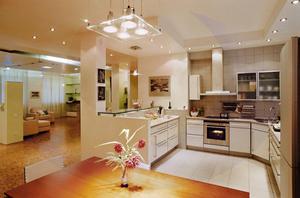 Any of the lighting has certain criteria to recognize the light as wrong or right. Moreover, several factors are taken into account, which also have a significant impact on the conditions of kitchen lighting.
Any of the lighting has certain criteria to recognize the light as wrong or right. Moreover, several factors are taken into account, which also have a significant impact on the conditions of kitchen lighting.
Natural light is created by diffused and direct sunlight. The conditions of light change throughout the night and night and depend, in this case:
- from the presence of clouds in the sky;
- from the geographical location of the city or locality;
- window locations;
- size of window openings;
- level of glass pollution.
If the windows are oriented to the west or north, then they let in less light. The room must be decorated with light materials for decoration, bright photos, because the light hitting these surfaces is reflected and increases the level of light.
Let us describe the stages of the dependence of the illumination of the room, taking into account the colors of the finish. The value of the coefficient shows the amount of illumination from the color of the walls, which remains after reflection.
- white - 0.9;
- cream - 0.8;
- light gray, 0.6;
- light green - 0.43;
- brown - 0.13.
Also, the quality of light significantly depends on the cleanliness of the double-glazed windows. Dusty and dirty windows hold up to 25% of the light. In order to have light in the kitchen during the daytime, it is necessary to periodically wash the glass on the windows.
If for some reason there is not enough lighting in the daytime, then it is desirable to "light up" the kitchen fluorescent lamps. They are quite economical and in terms of characteristics are close to natural light. If there is a lot of light from the sun, then blinds can be used.
Artificial light helps to create comfortable conditions in the kitchen in the evening. Lamps must be bright, but not blinding. Lamp must evenly illuminate the entire kitchen, eliminating glare from walls, furniture, countertops, photos and does not cause strong shadows.
Photo examples of kitchen lighting
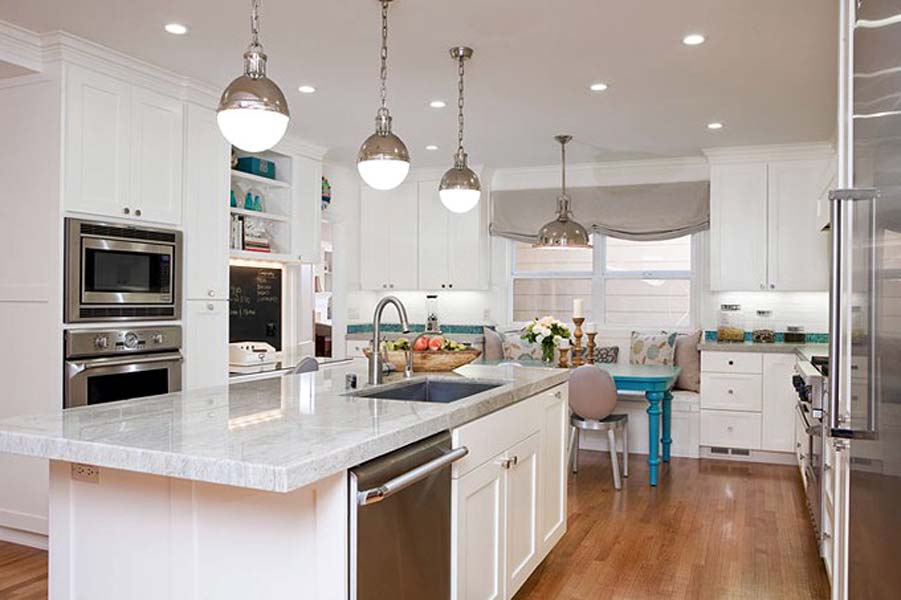
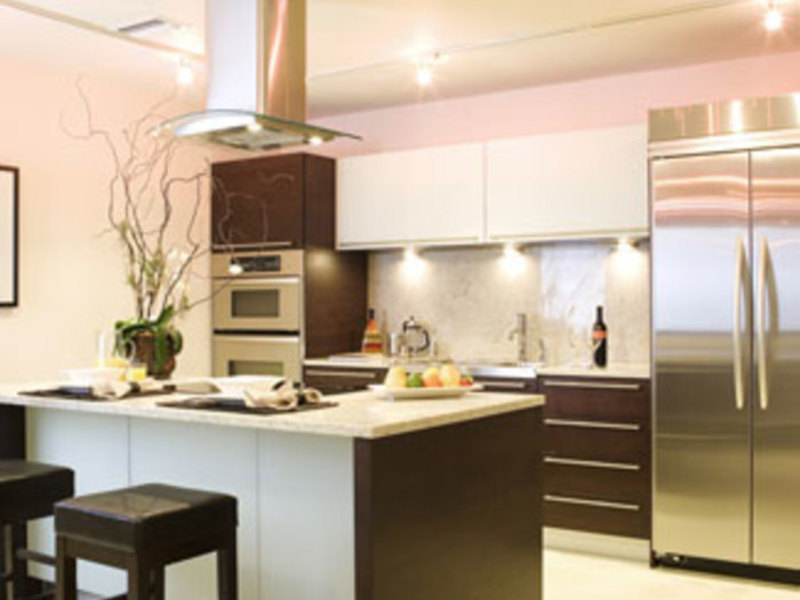
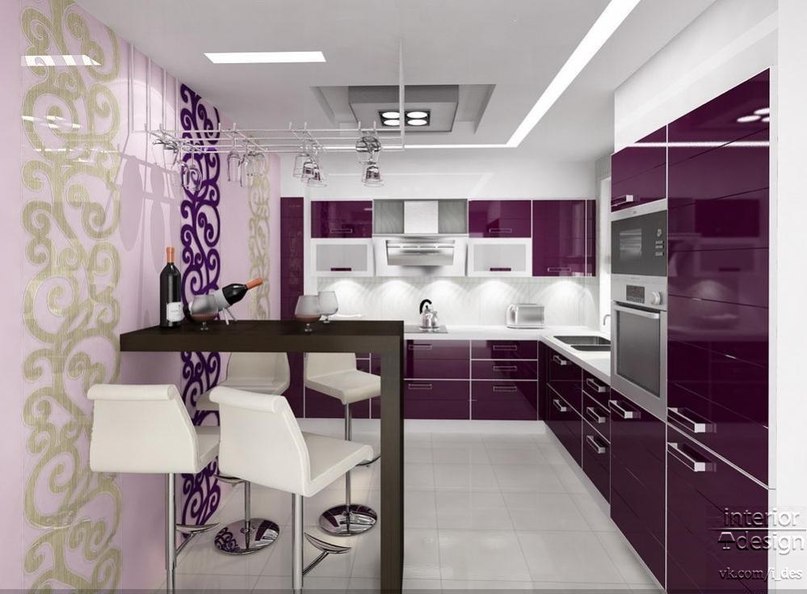
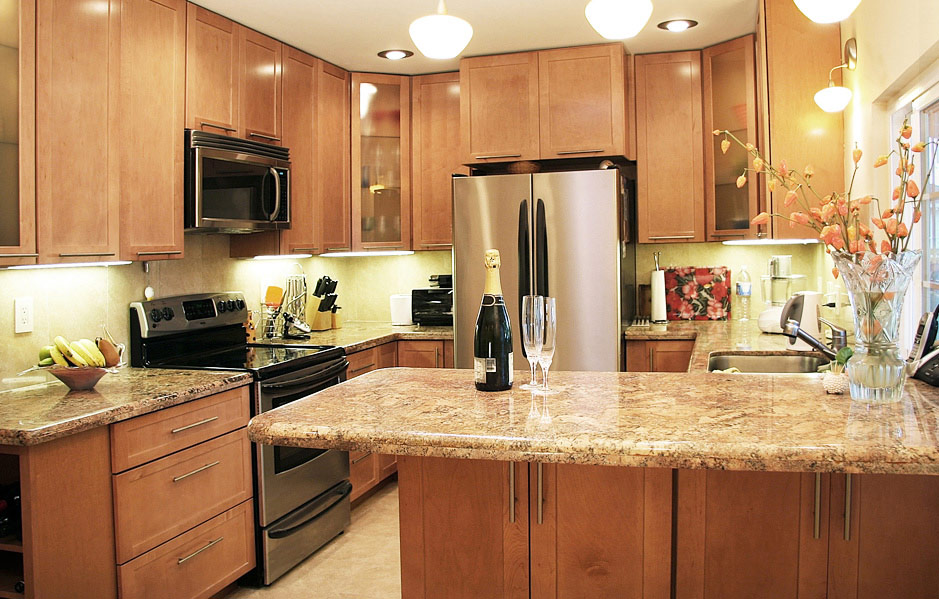
![]()
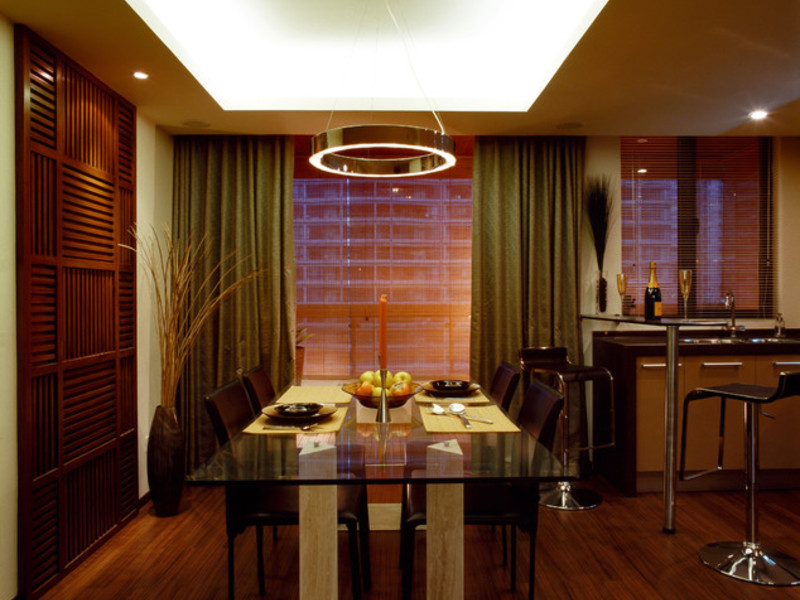
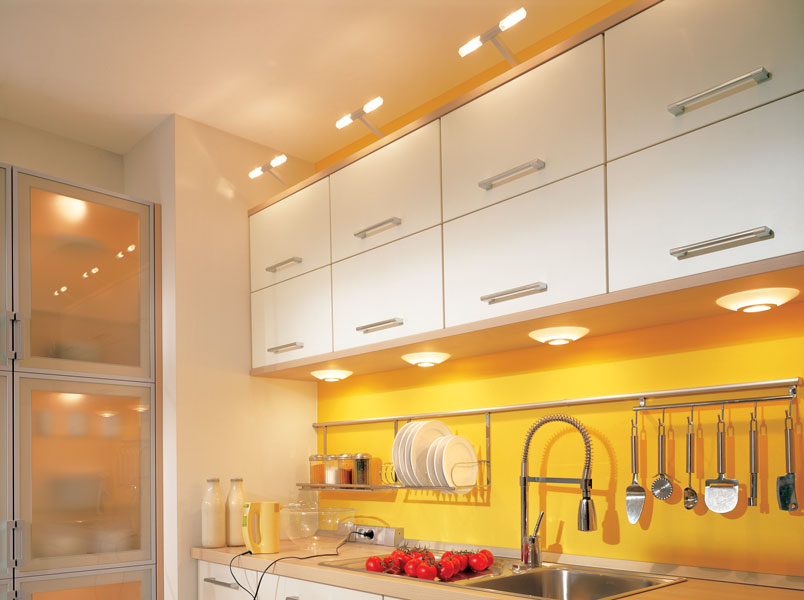
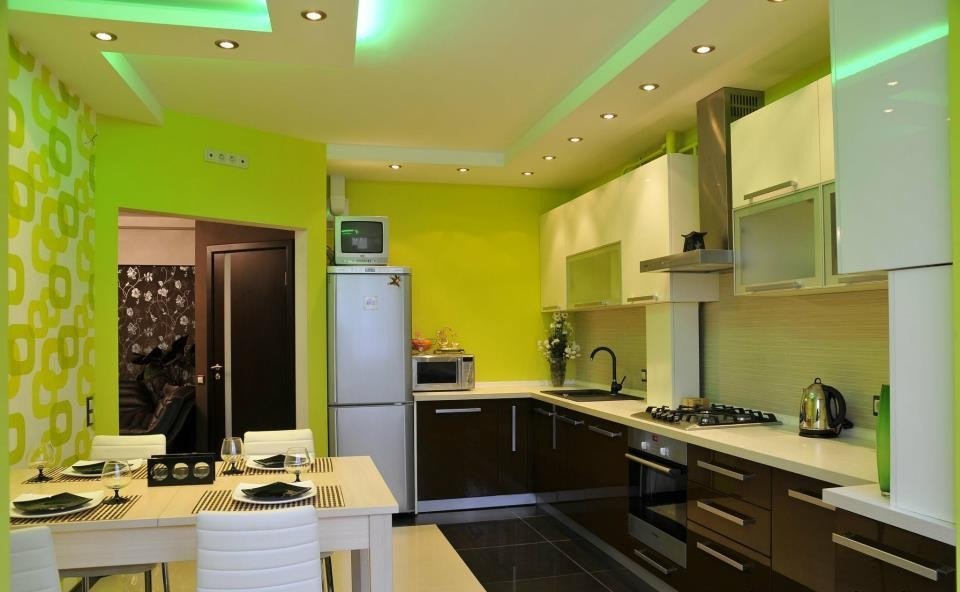
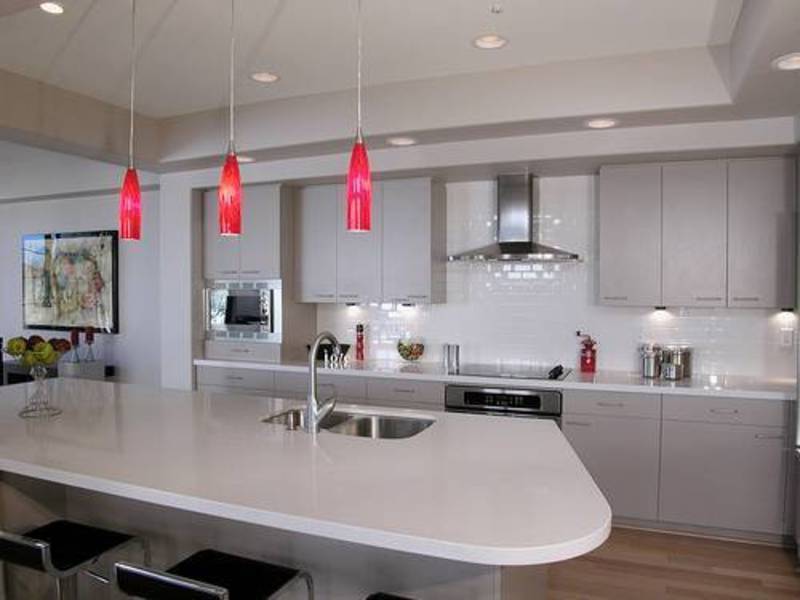
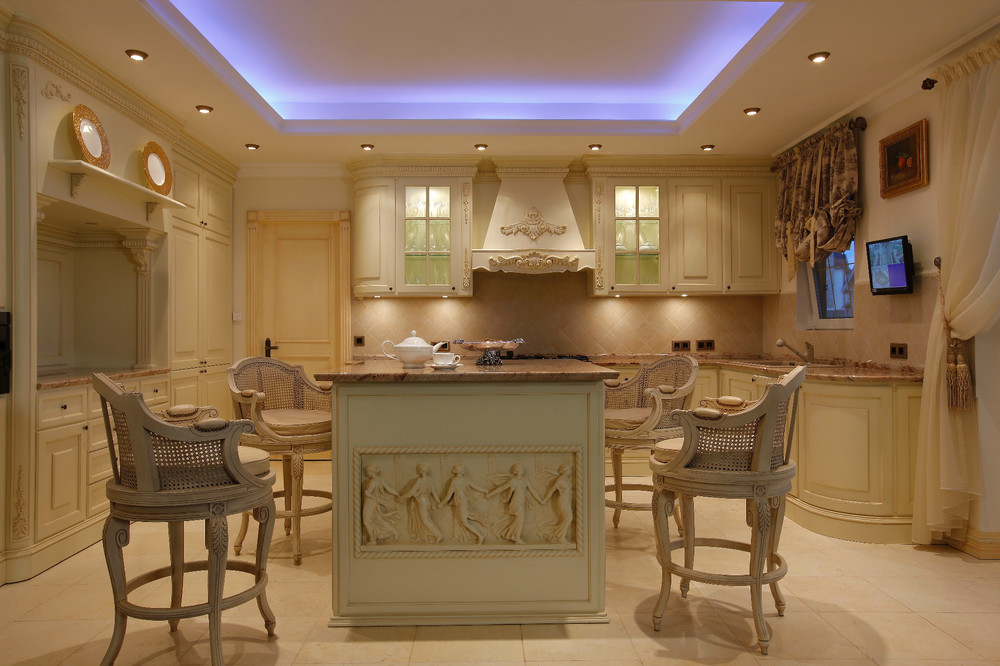
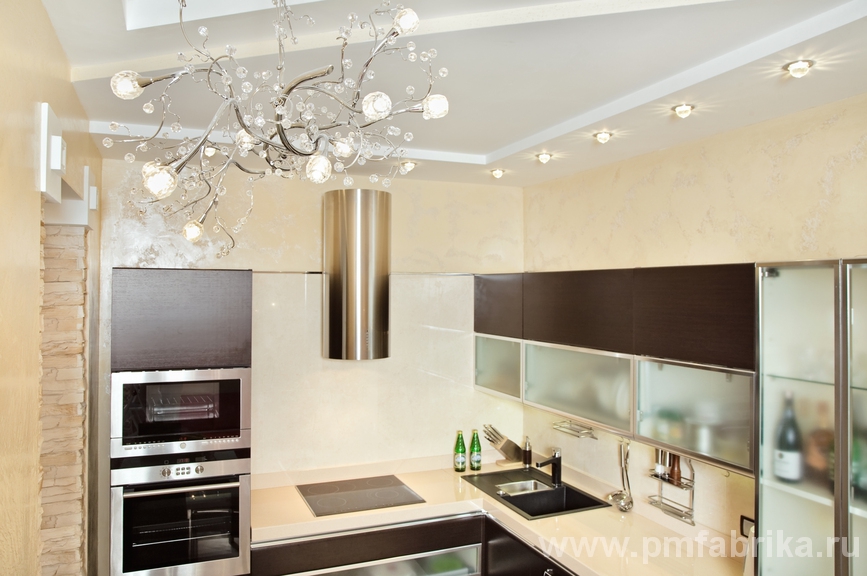
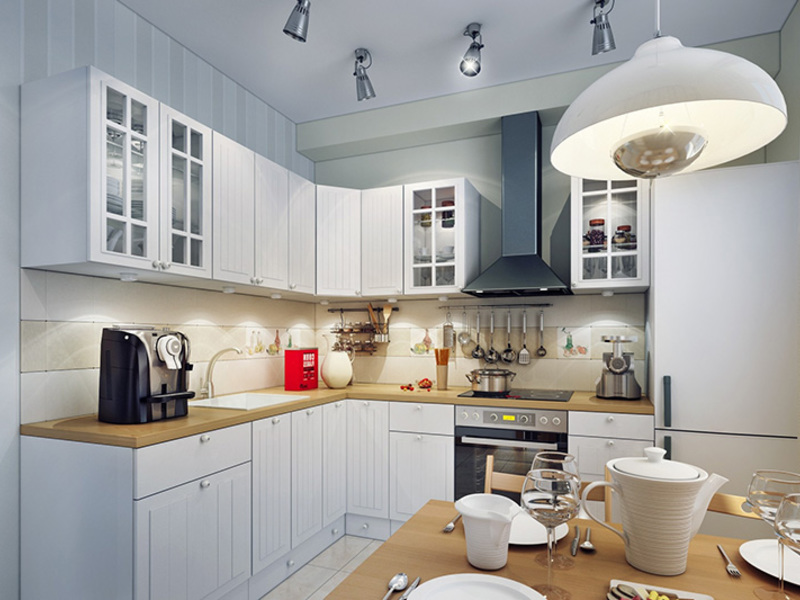
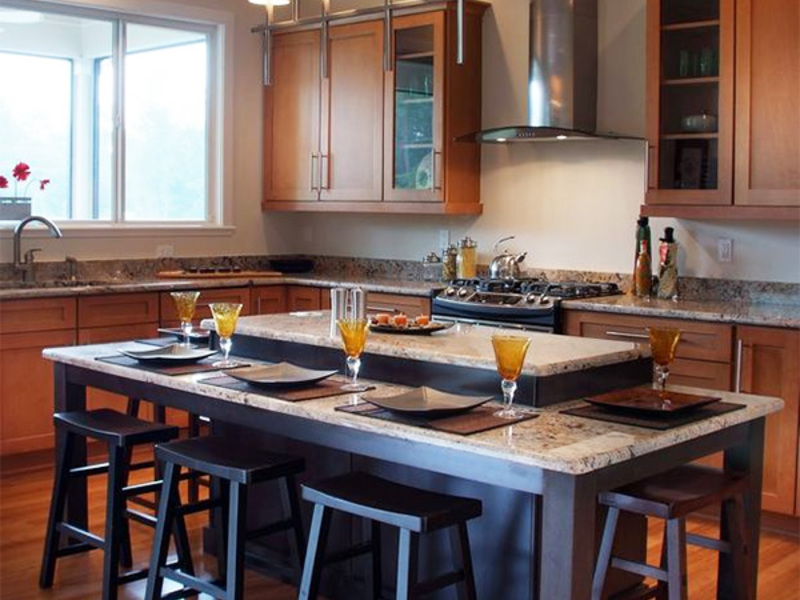
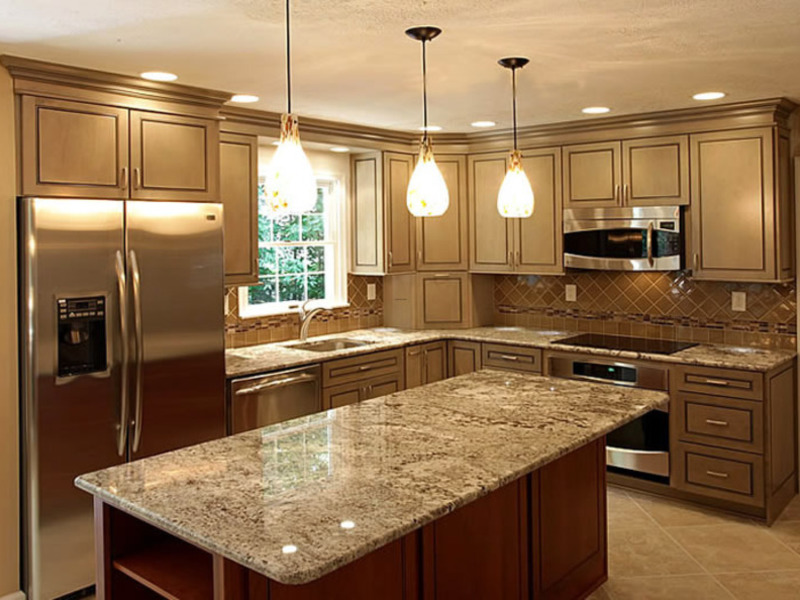
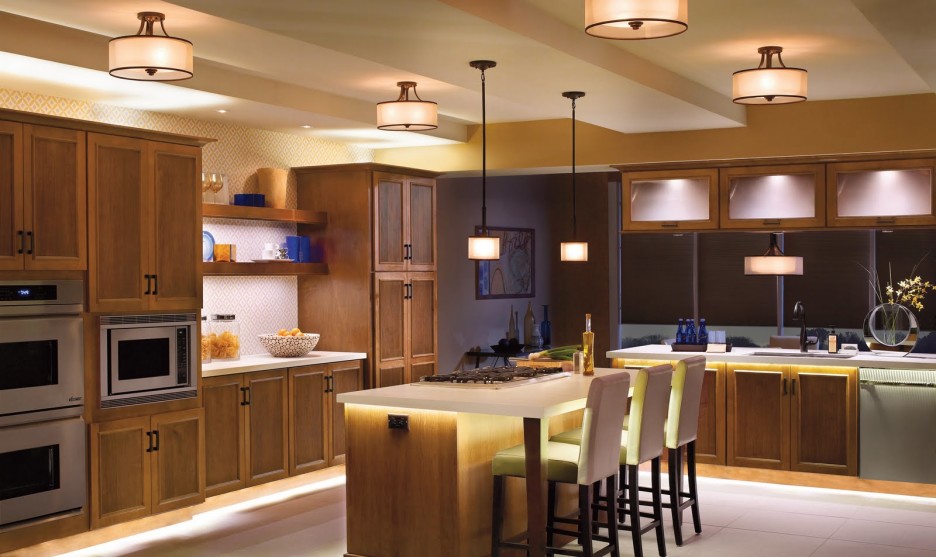
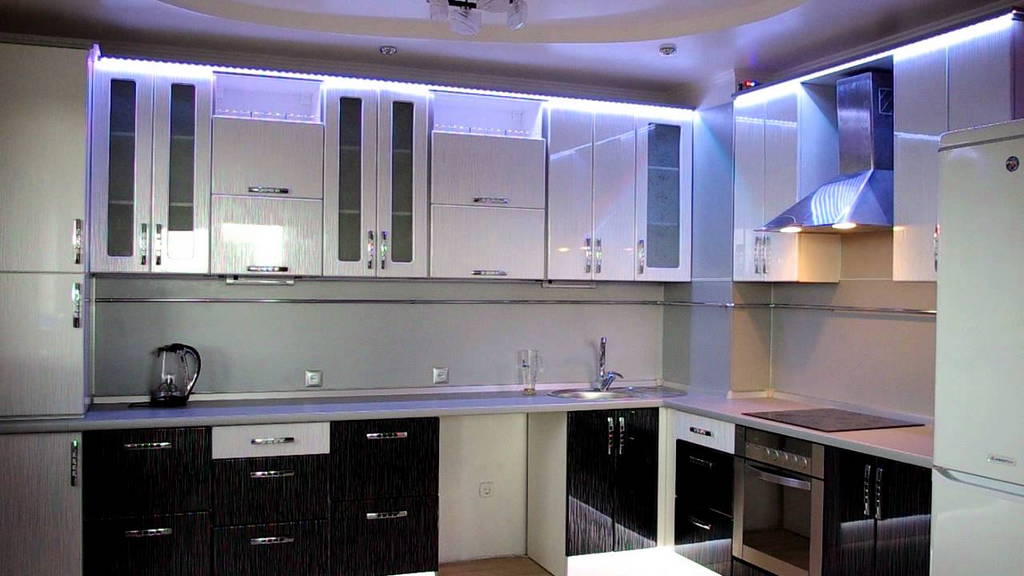
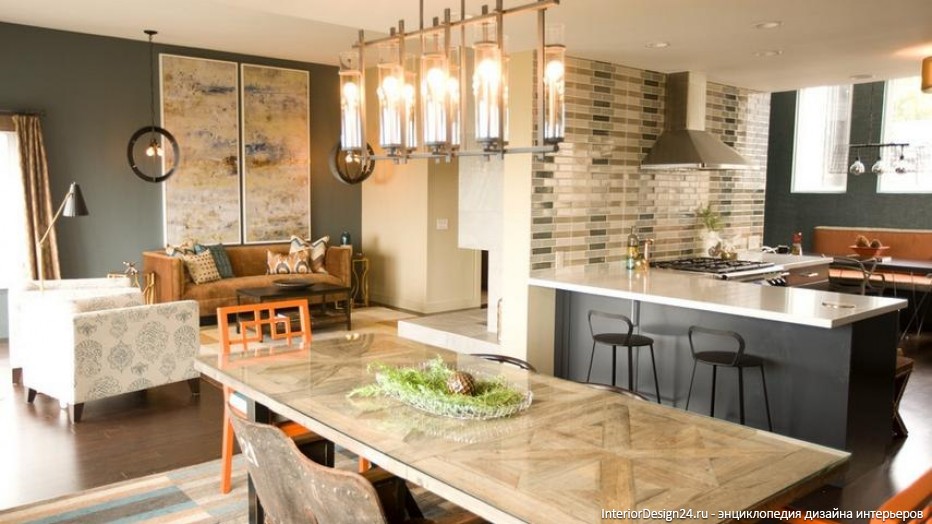
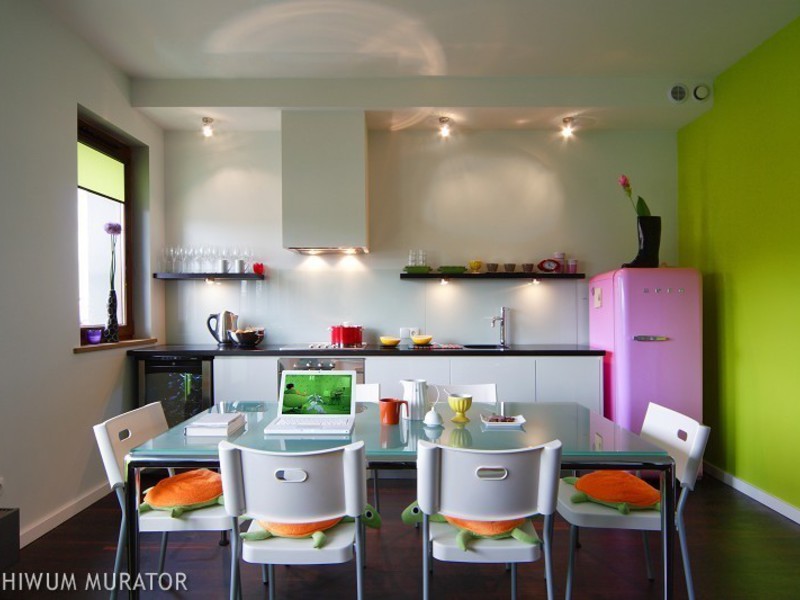
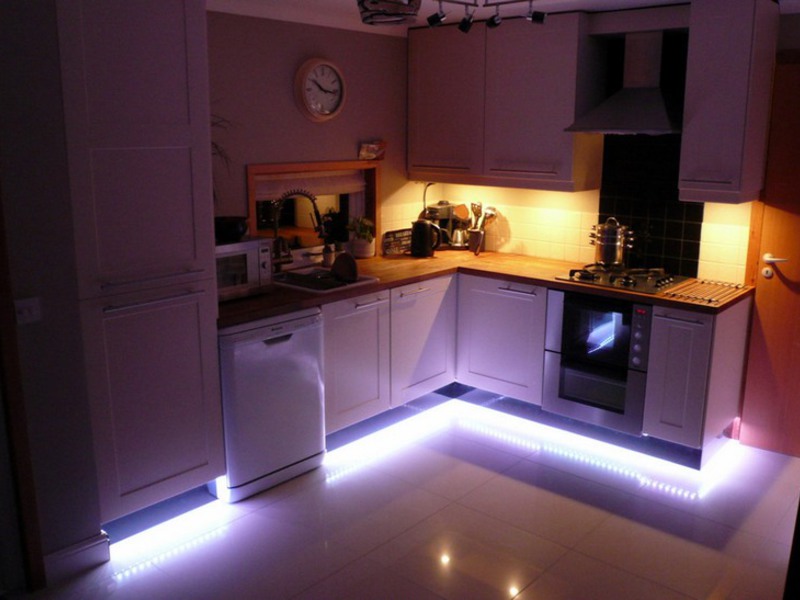
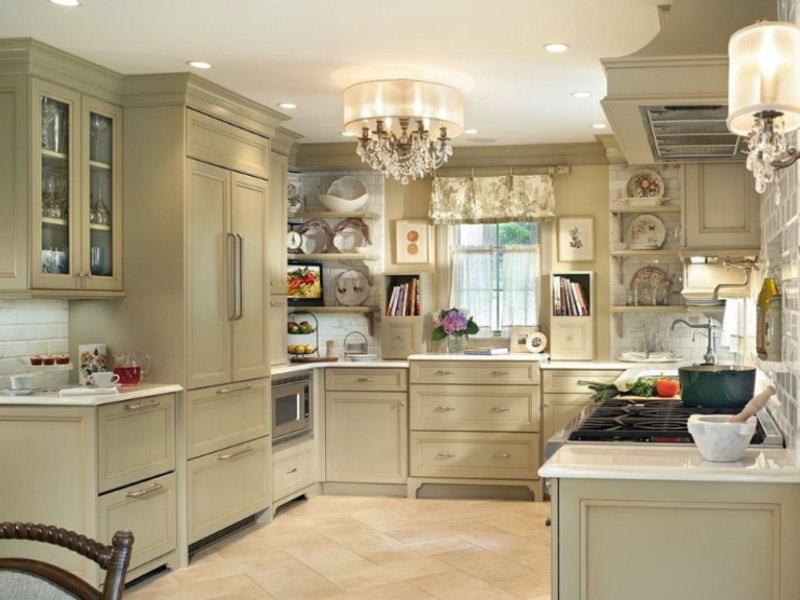
Criteria for kitchen lighting
Local and general luminaires
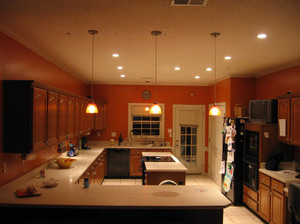 It's absolutely different kinds lighting and they create a different atmosphere in the room. With general lighting, the kitchen is flooded with quite bright lighting, when you can easily go about your business while not requiring eye strain. Ceiling lamp, installed in the center of the room, directs the light to the top and diverges evenly throughout the room. There is the option of directional light for a specific area, such as a work area. In this case, the light of this lamp goes down.
It's absolutely different kinds lighting and they create a different atmosphere in the room. With general lighting, the kitchen is flooded with quite bright lighting, when you can easily go about your business while not requiring eye strain. Ceiling lamp, installed in the center of the room, directs the light to the top and diverges evenly throughout the room. There is the option of directional light for a specific area, such as a work area. In this case, the light of this lamp goes down.
But general lighting is not enough when many types of work take place in the kitchen - cleaning, cooking, preparing food, washing dishes, eating, and so on. The problem is perfectly solved by ceiling local lighting, while the lamps are installed directly above the working area. Thus, hobs, sinks, dining area, work surfaces, kitchen furniture and even shelves or photos are illuminated. For this, ceiling fluorescent and spotlights, lamps of various designs and directions can be used.
Ceiling light decoration
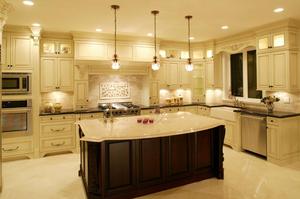 As already described above, the function of a general or overhead light is to create a comfortable atmosphere in the kitchen in the evening. The overhead light is quite relevant in the case when the kitchen is combined with the living room, and natural light does not pass into it. The most important thing when planning ceiling lights is that the lighting in the kitchen is not very intrusive or very dim. In open floor plans, the best option is using dimmer switches, they smoothly change the brightness. During the day, if there is no need for bright light, it is possible to “dim” the lamps. In the evening, set the brightness to maximum.
As already described above, the function of a general or overhead light is to create a comfortable atmosphere in the kitchen in the evening. The overhead light is quite relevant in the case when the kitchen is combined with the living room, and natural light does not pass into it. The most important thing when planning ceiling lights is that the lighting in the kitchen is not very intrusive or very dim. In open floor plans, the best option is using dimmer switches, they smoothly change the brightness. During the day, if there is no need for bright light, it is possible to “dim” the lamps. In the evening, set the brightness to maximum.
If the kitchen is small, then one common lamp is enough. If the kitchen is quite large, then you can additionally install several point ones. Another option is several lamps on the ceiling, located at the same distance. It happens that it is not advisable to flood the entire room brightly, choosing powerful lamps, but to place chandeliers over the main functional areas, where, as a rule, the family gathers, some work takes place, the owners of the house and their friends rest, for example, above the dining area and bar counter.
A very low ceiling does not need to be overloaded with lamps, they should not be fixed with long cords. An elegant cornice on the ceiling can be a great place to arrange small lamps that will illuminate the room with diffused and pleasant light. When the height of the ceiling allows, then you can install groups of lamps and cause decorative or bright lighting.
You can decorate the general light with the help of a kitchen furniture cornice. Here you can evenly distribute point lighting devices and they will be enough for a comfortable atmosphere. If the furniture is not equipped with a cornice, then they can be placed on movable or elastic brackets. This arrangement will enable adjust light direction and highlight the area needed at that time.
Illumination of individual zones
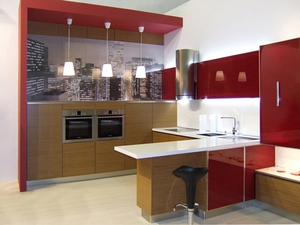 The kitchen is a functional room where food is prepared and the whole family gathers for breakfast or lunch. Often overhead lighting is lacking near sinks or countertops. Priority must be given to local illumination, and the general one only complements it.
The kitchen is a functional room where food is prepared and the whole family gathers for breakfast or lunch. Often overhead lighting is lacking near sinks or countertops. Priority must be given to local illumination, and the general one only complements it.
Working illumination is made out by separate fixtures. Perhaps there will be several. But local lighting is effective only when it is at a certain level, in a carefully thought-out place and allows you to brightly highlight a specific area:
- hob;
- countertop;
- sink;
- bar counter;
- dining area, etc.
Typically, the hob can be perfectly illuminated by a lamp mounted in the hood. But, if auxiliary lamps are installed in the hood, then in order to prevent eye fatigue need to select light sources with similar spectral properties.
The most popular way of arranging local lighting is lamps mounted under the shelves. Most The best way- elongated lamps that scatter light and effectively illuminate a certain area. These lamps are discreet, they do not require much space, they are easy to install.
To equip autonomous lamps, you need to display separate switches or sockets. And if local lamps are built into kitchen furniture, then you can only run a cable from the wall, which will be located just above the bottom of the hanging cabinets.
The tabletop must also be clearly visible. Hidden light sources do not interfere with work and do not interfere with the use of kitchen utensils, which are sometimes quite a lot above the work area and directly on it. But, when the owners of the house love the perfect order, and all the utensils are in cabinets and drawers, then local illumination can be done using original products, which have the most fantasy forms.
Often, kitchen areas are illuminated with autonomous lamps. Their choice is quite huge, the most important thing is that they do not contradict the style of the room. One of the most popular types is lamps on clothespins. They can be fixed anywhere and, if necessary, put away in a closet.
kitchen island lighting
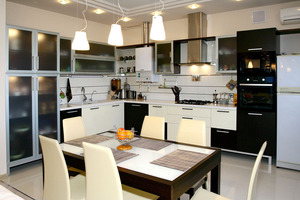 The kitchen island must be illuminated with general light, for example, using spotlights located around the perimeter or installed on the ceiling eaves. big attention should be paid to the illumination of the island because it is here that all the main work is carried out.
The kitchen island must be illuminated with general light, for example, using spotlights located around the perimeter or installed on the ceiling eaves. big attention should be paid to the illumination of the island because it is here that all the main work is carried out.
The plate is very easy to light up. This area is equipped with a hood with installed fixtures that create a bright light. In combination with overhead lighting, this is quite enough.
If the island does not have a hob, then effective lighting can be done using lamps on long cords. Lighting should not blind, therefore, for these purposes, chandeliers with "milky" or matte lampshades are the best. Chandeliers should not go beyond the outline of the island, they are best installed along the axis of the countertop. The number of chandeliers is not clearly regulated. They are selected according to specific conditions.
The most convenient and fashionable option is installation of a special hinged structure where the spotlight is installed. Most often, a variety of accessories or kitchen utensils are also placed on this design.
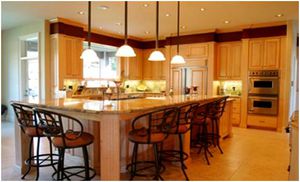 The simplest option is considered to be a "hanging" lamp on a string. Fabric lampshades with fringe are a clear sign of home comfort. This option is not abandoned even today. It is relevant because the dining table is visible as efficiently as possible. And the shape and color are selected taking into account the style of the room. The lampshade can be chosen avant-garde or simple, pretentious or original. The main thing is that the table is fully visible, and the rest of the decor can be filled with pleasant twilight, diluted with multi-colored spots or stripes from the light passing through the lampshade.
The simplest option is considered to be a "hanging" lamp on a string. Fabric lampshades with fringe are a clear sign of home comfort. This option is not abandoned even today. It is relevant because the dining table is visible as efficiently as possible. And the shape and color are selected taking into account the style of the room. The lampshade can be chosen avant-garde or simple, pretentious or original. The main thing is that the table is fully visible, and the rest of the decor can be filled with pleasant twilight, diluted with multi-colored spots or stripes from the light passing through the lampshade.
And how to highlight the dining area when the table is near the wall? The table can be illuminated by sconces mounted on the wall. They should not be at very high altitudes. A variety of sconces can be attached to the wall. It depends on the preferences of the owner. If there is enough space on the table, then it can be illuminated with a table lamp with a beautiful lampshade. This will give the kitchen even more coziness, decorate the dining area and evoke an intimate and pleasant atmosphere for relaxing in the evening.
If the location of the table changes all the time, then it makes no sense to make a hole in the ceiling and install a lamp. In this case, the table can be illuminated with a table lamp or floor lamp.
A large table, where the whole family from several generations converges, can be distinguished by a group of spotlights located on the ceiling along the contour of the dining area. You can also use small lamps on long cords or install a rod. Lighting can be set arbitrarily or in any order convenient for you, as well as create original compositions.
When decorating kitchen lighting, it is necessary that it does not distort natural look and the color of the food so that the food on the table looks appetizing and attractive. For this it is desirable to select lamps with a neutral spectrum. Diffused and soft light will evoke a favorable environment. And for a room like a kitchen, this is important.
The kitchen should be filled with light. But when this cannot be done through windows, ceiling lights come to the rescue.
Varieties
There are many types of ceiling lamps, but they can be divided into three main groups.
Chandelier
AT modern interiors kitchens, it is no longer as widely used as it used to be. But in classic interiors she has a place now. Still, you can’t do without it in large kitchens, where a separate area is allocated for the dining table, which needs separate light. Many will say that a chandelier is inconvenient, it hides space, but this is not entirely true. Modern designers are developing various forms of chandeliers. These are not only ceiling lamps hanging over your head, not very suitable for small kitchens, but also various lamps stretched along a horizontal plane that will not bother you. The chandelier, of course, will not be able to illuminate all the far corners, but it can be combined with local lighting.
Spotlights
This type of lamp is perfect if your kitchen has suspended or stretch ceilings. In most cases, they are used as local illumination. But there are design options when spotlights are used to illuminate the entire kitchen as a whole. Especially often it is used in a small kitchen.
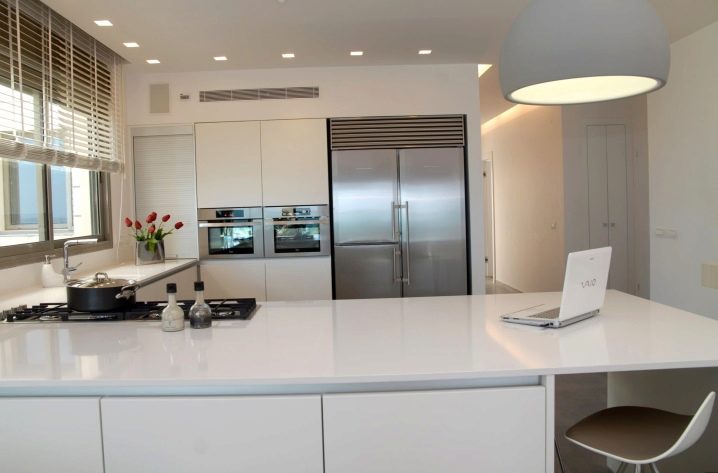
Pendant lamps
As in the previous group, they are most often used to illuminate the work area and the area above the table where food is taken. Most often this is a group of the same spotlights, which are installed on a common panel, and it, in turn, is attached to the ceiling. They shine well, but for some reason they are not widely used.
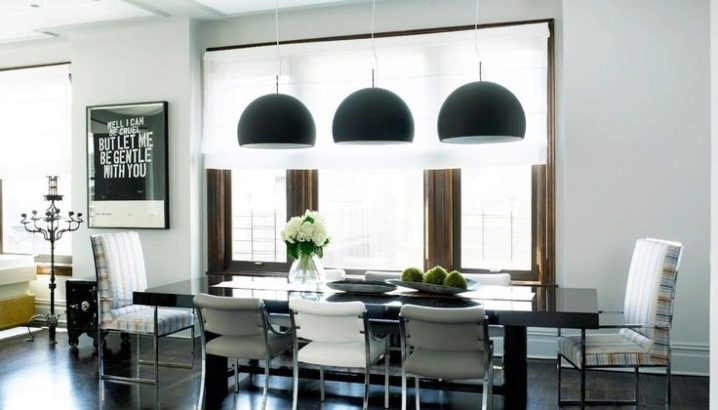
There are also a lot of varieties of light in lamps.
- incandescent. These are ordinary lamps that are screwed into spotlights, or a chandelier. They do not shine very brightly, but they consume electricity in huge sizes.
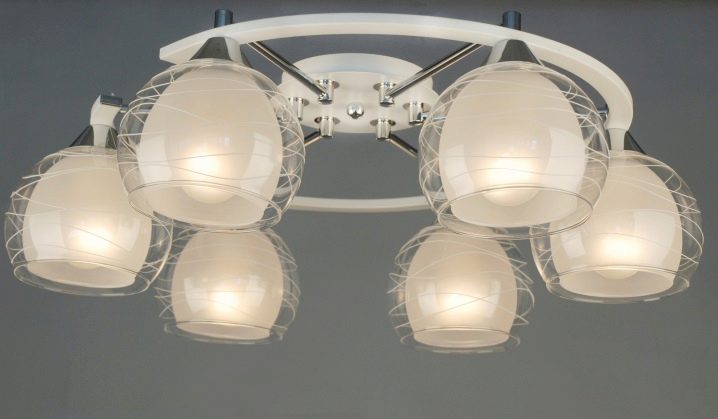
- Halogen. They shine brightly, they are used, as well as incandescent lamps, in chandeliers and spotlights. Energy consumption on a par with incandescent lamps. It is dangerous to use in PVC ceilings due to the fact that they get very hot.
- Fluorescent- this is energy-saving lamps, have the same range of applications as the two previous paragraphs, but their power consumption is 5 times less.
- LED. This view is a strip with many LEDs that can also be mounted on the ceiling to illuminate the work area, or to emphasize different levels ceiling. They shine brightly, consume a minimum amount of electricity, but are not cheap.
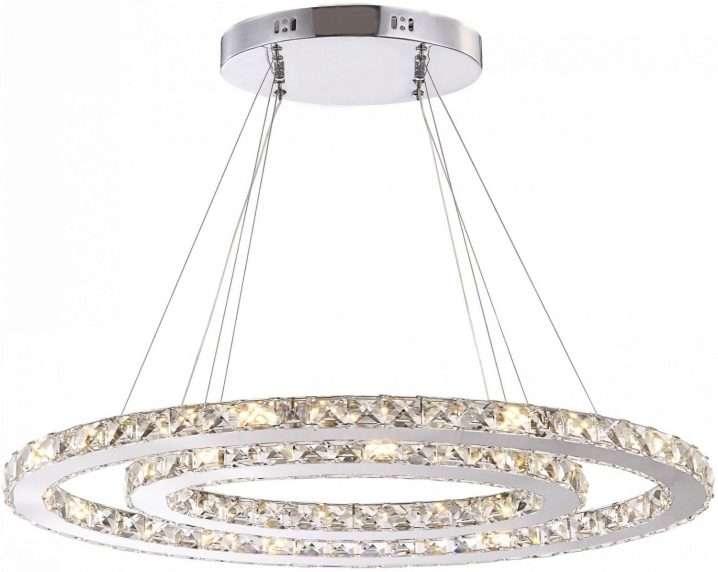
According to the type of installation, they distinguish
- embedded;
- invoices;
- suspended;
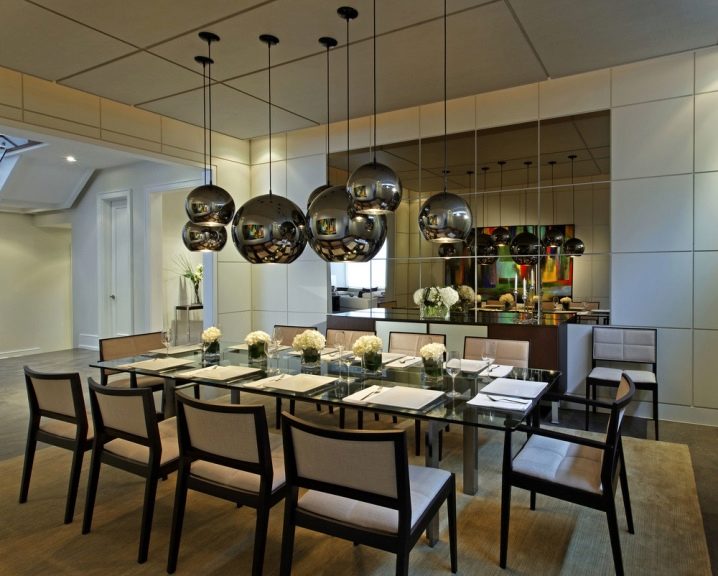
Recessed - these are models of spotlights. Their name speaks for itself. They are built into suspended or stretch ceilings. There are built-in lamps of directional radiation or rotary.
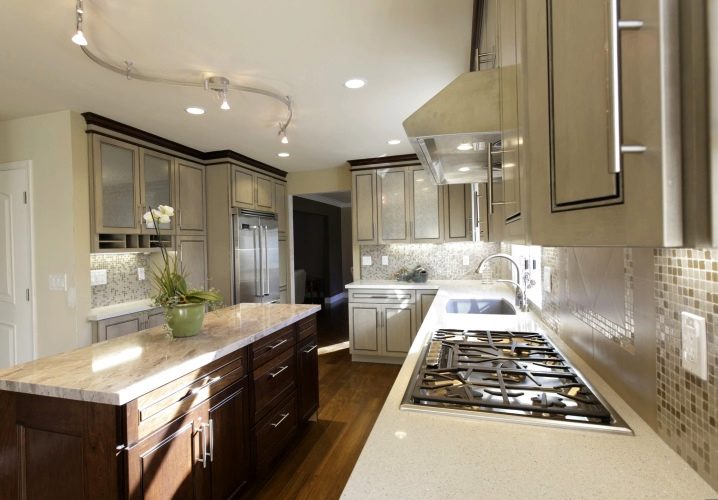
Overhead lights - screwed to the ceiling. The main requirement is a rigid foundation. They are either round (square) or rectangular (oval). With a rectangular overlay, the lamp will visually stretch the space.
Suspended ones are arranged in large kitchens, usually in the dining table area. They are hung on a hook in the ceiling and are the main lighting fixture in the interior.
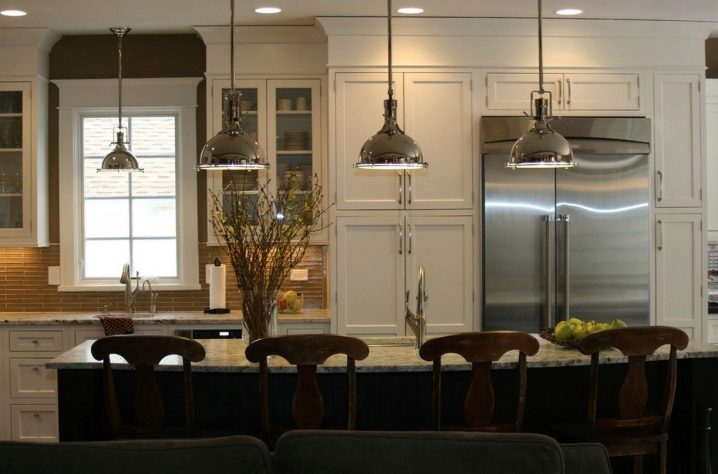
Features and Benefits
Illumination in the kitchen carries not only the role of lighting, but also has an aesthetic component. Not only the convenience of cooking, but also your comfortable stay in the kitchen will depend on the quality of the selected fixtures. That is why the choice of kitchen lighting fixtures must be approached thoroughly.
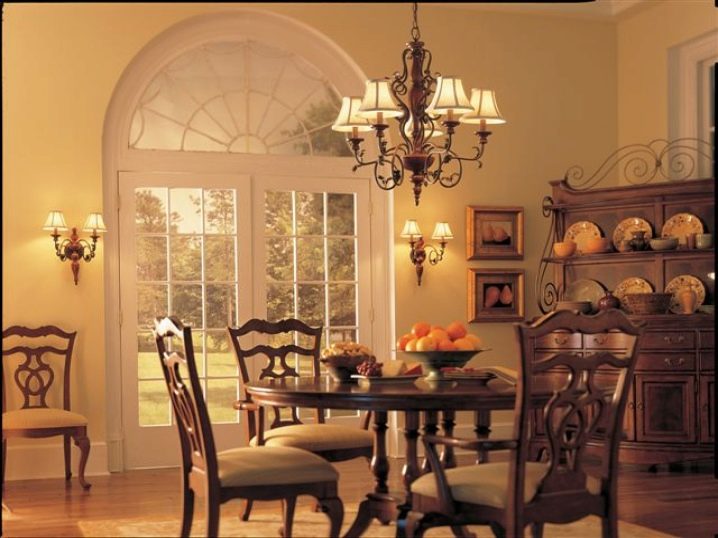
Each type of fixtures described above has a place to be on the kitchen ceiling.
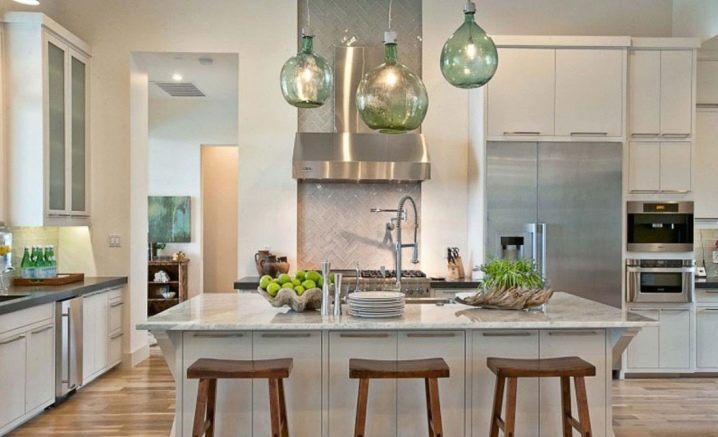
Hanging chandeliers are suitable for large kitchens, small, they will clutter up, hiding an already small space.
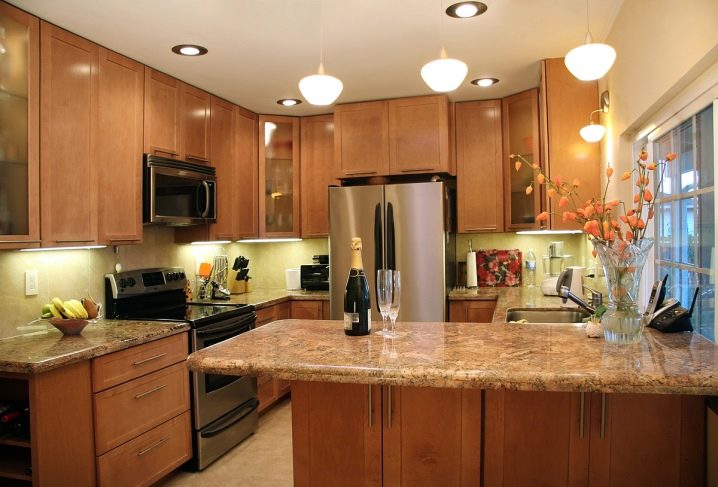
Overhead lights, on the contrary, are suitable for a small kitchen. They will not take up space, and if you choose an oval or rectangular shape, they will push it apart.
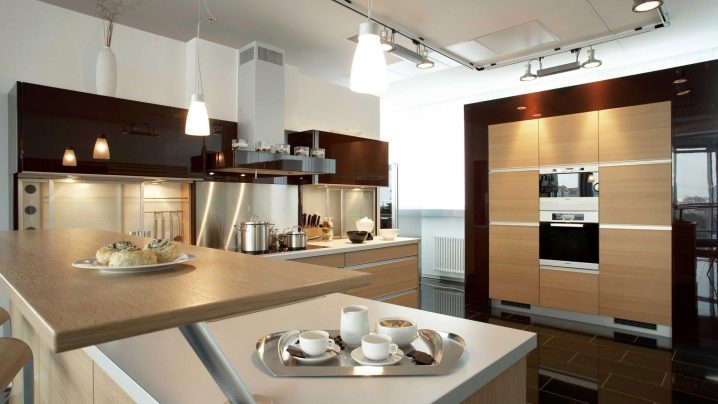
Spotlights are installed in false ceilings, in the zone of illumination of the working area. In a small kitchen, they can also be installed as the main light, then the best option would be to connect the cooking area to a separate switch.
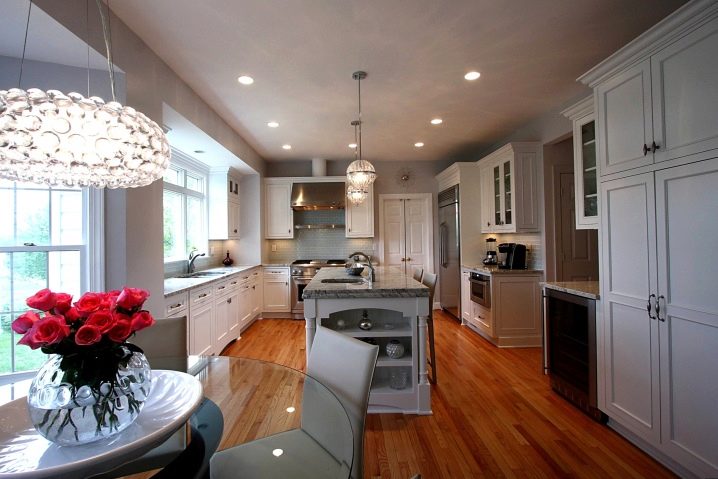
In the work area, it is better to install lanterns with a turn so that you can direct the light directly onto the cutting table.
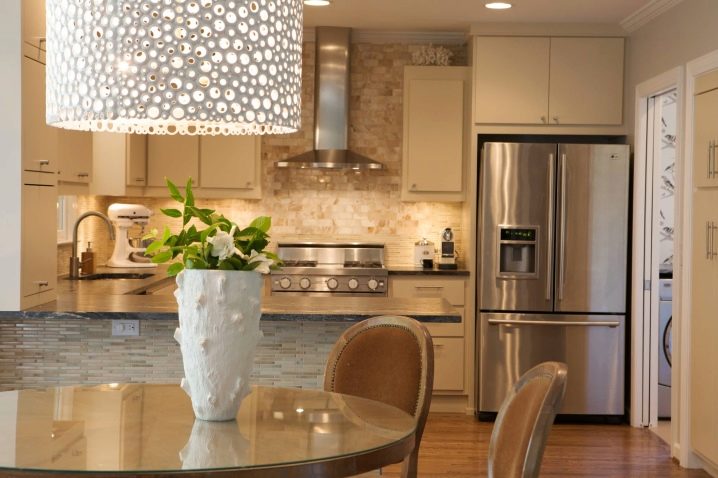
Lamps with LEDs will help not only save electricity, but also illuminate a multi-level ceiling, thereby visually increasing the space.
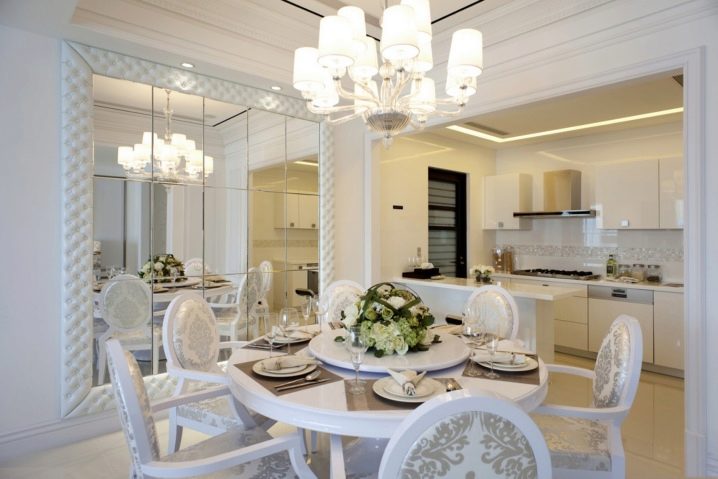
Based on the style of your kitchen, you can choose between warm and cold light fixtures. It is worth remembering that warm light increases the sharpness of colors, and cold lighting can distort their transmission. So, blue may turn out to be with a greenish tint, and red will turn into brown. Therefore, choose the colors of finishes and furniture more carefully if you decide to use cold lighting. By the way, food will look more appetizing in warm light.
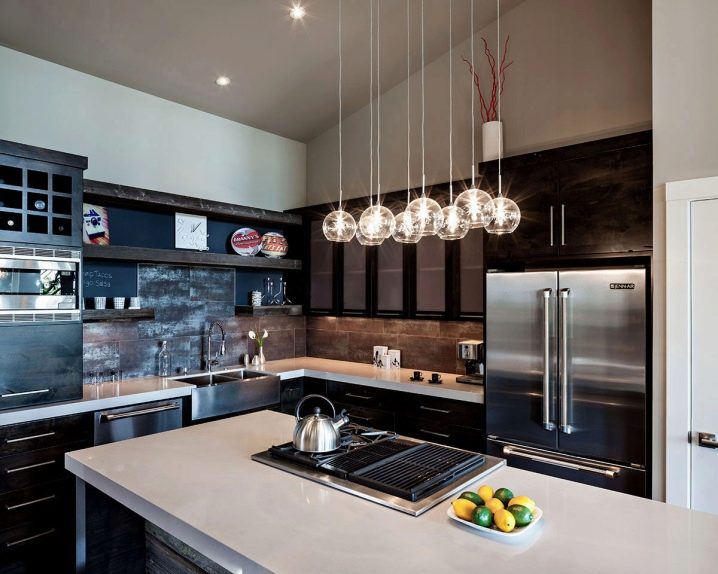
colors
Basically, in the kitchen, standard colors of fixtures are used. The case is made in the color of gold and silver, White color is also not uncommon. They can be either glossy or matte - it all depends on your preference. Plafonds, if we are talking about overhead and pendant lamps, can be of any color scheme. The main thing is that they harmoniously fit into the overall interior of the kitchen.
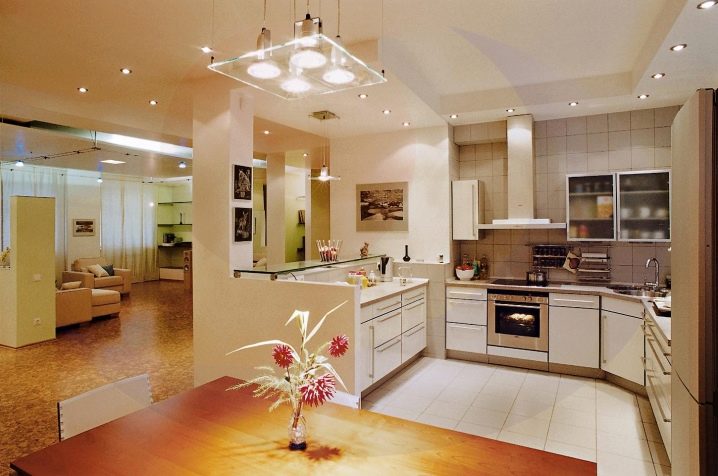
If you want to accentuate and liven up a boring kitchen, for example in black and white, then install a deep red chandelier on it. This will help create a very stylish interior.
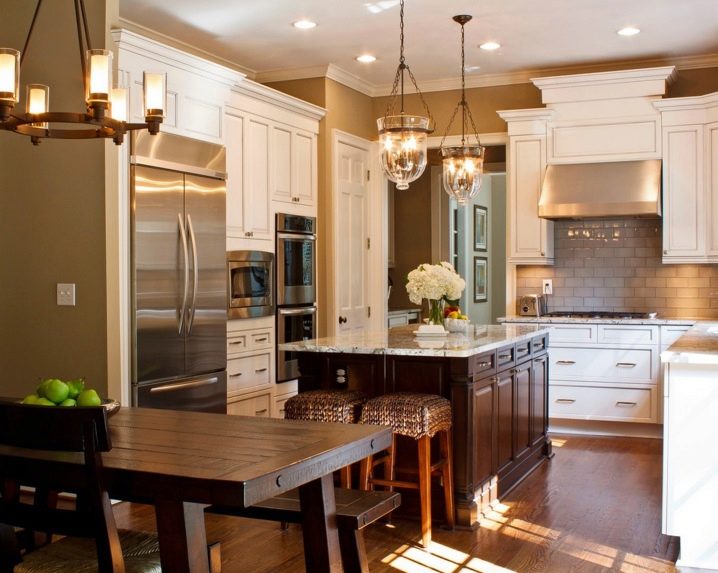
materials
The materials used in lamps are standard - metal, glass. But it is permissible to use designer things. For example, a wicker lamp would look great in a kitchen space. You can also use various wooden, cork parts in chandeliers. It all depends on your interior and flight of fancy.
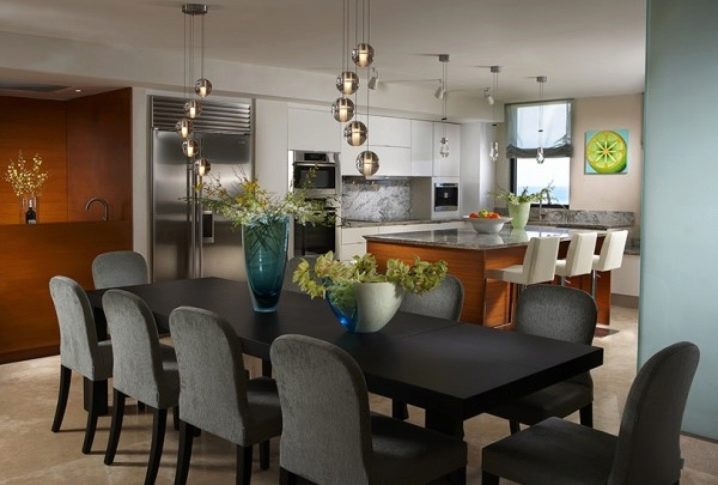
The choice of ceiling lamps for the kitchen is very large, and how to find exactly what you need.
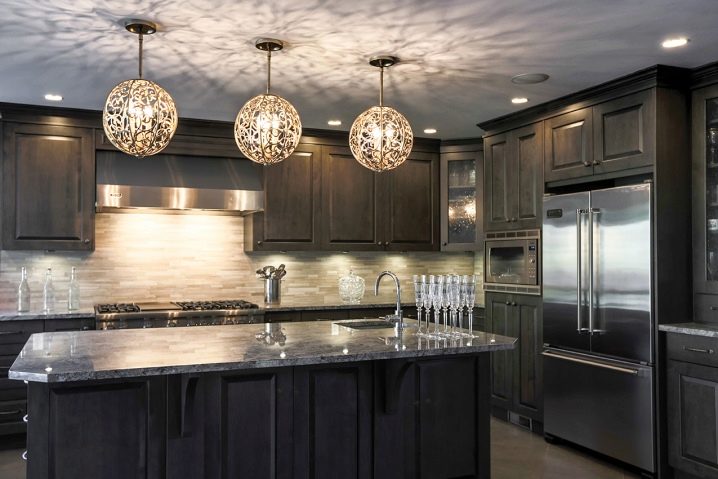
First of all, you need to take it seriously, with a clear idea of \u200b\u200bwhat you want, and make the lighting in the kitchen comfortable, no matter what you do there.
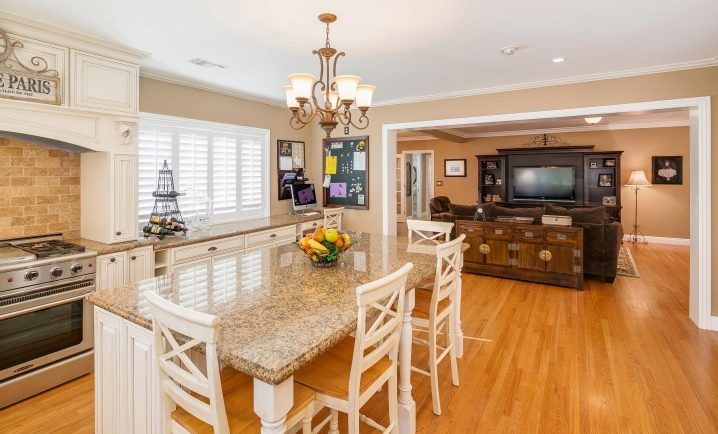
- You can not limit the lighting of the kitchen to one lamp in the middle. Be sure to illuminate the work area. Otherwise, standing with your back to the light, you are blocking all the lighting, and it will not fall on the cutting table.
- You can not buy lamps before you decide on a kitchen set. First you need to draw up a kitchen project, determine where and what kind of light is needed, stretch the wires, and only then purchase lighting devices.
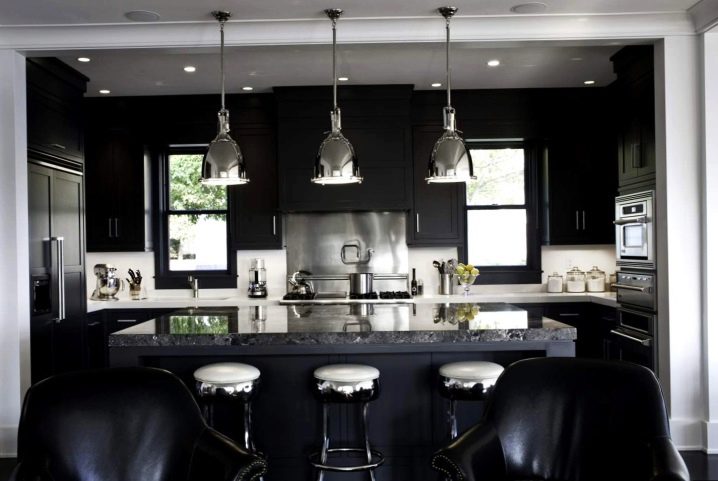
It would be nice to provide a switch in the kitchen with the ability to adjust the level of lighting, or at least divide the lamp lighting mode into two switches. This will help not only save on electricity, but also provide an opportunity to create a more intimate environment if necessary.
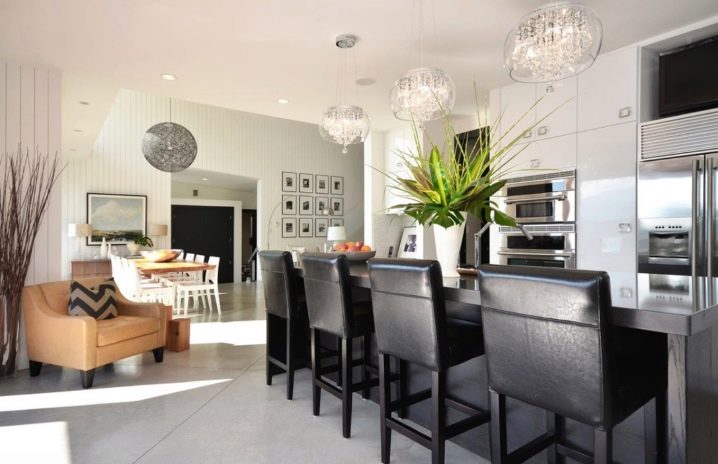
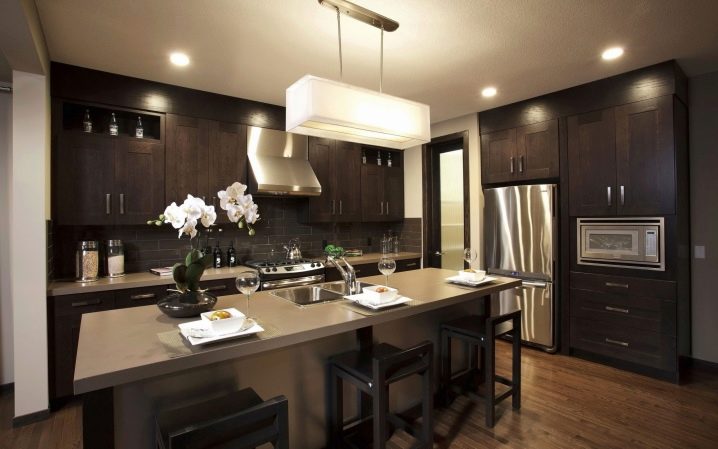
Usually it is illuminated with pendant lamps of unusual shapes, less often overhead ones.
The most effective placement of such shades is 1.5 m from the lamp to the table. You can hang one large ceiling, but it is allowed to place several throughout the table.
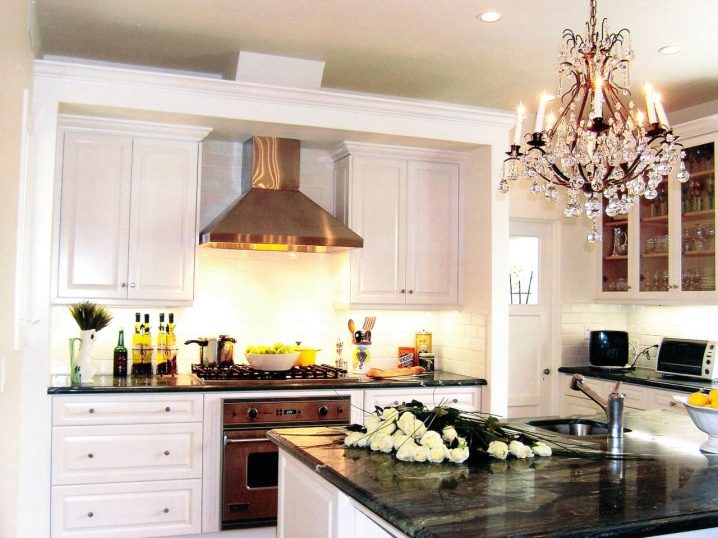
If the table is moved to the wall, you can illuminate it with the help of sconces or spots.
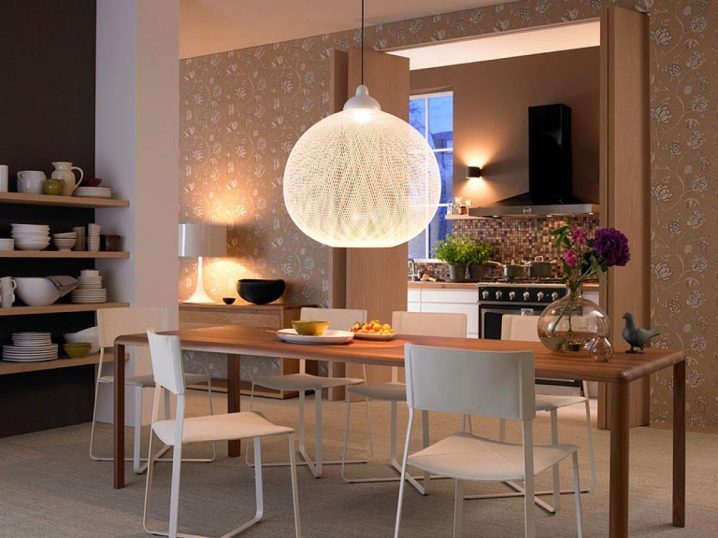
Do-it-yourself installation
Ceiling lights hanging and overhead type is not difficult to install yourself.
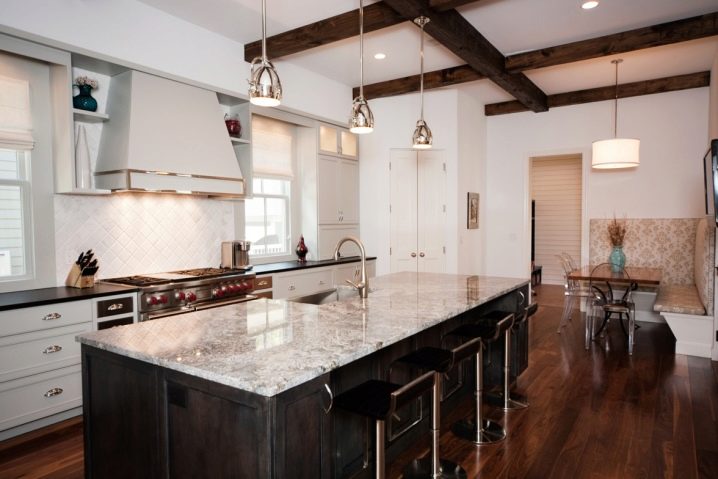
The hanging chandelier only needs to be hung on a special ceiling hook, having previously been connected to the wiring.
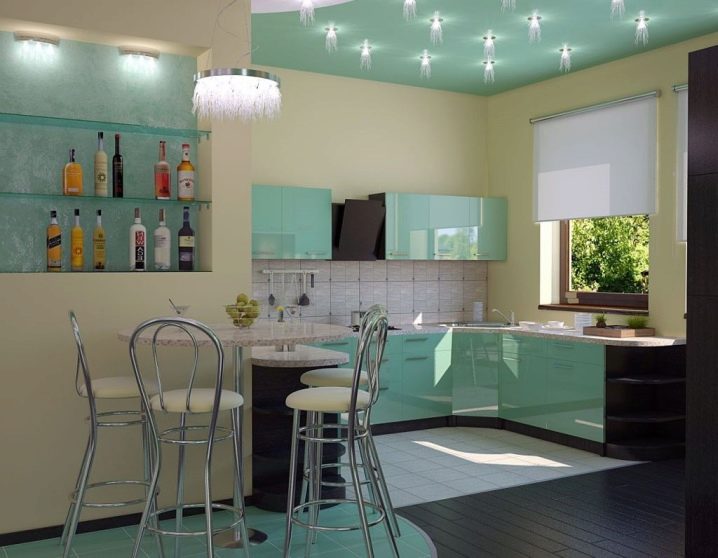
Overhead fixtures are screwed to the ceiling with a drill and dowels.
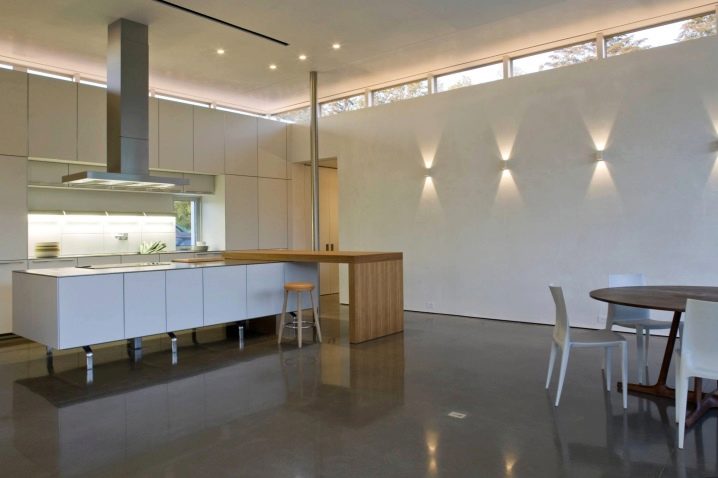
With built-in lights, everything is more complicated. They are mounted by the same specialists that install the ceiling. For lighting, places are pre-designed and wires are pulled, then, when mounting the ceiling, holes are cut out and power is connected to the lamps themselves.
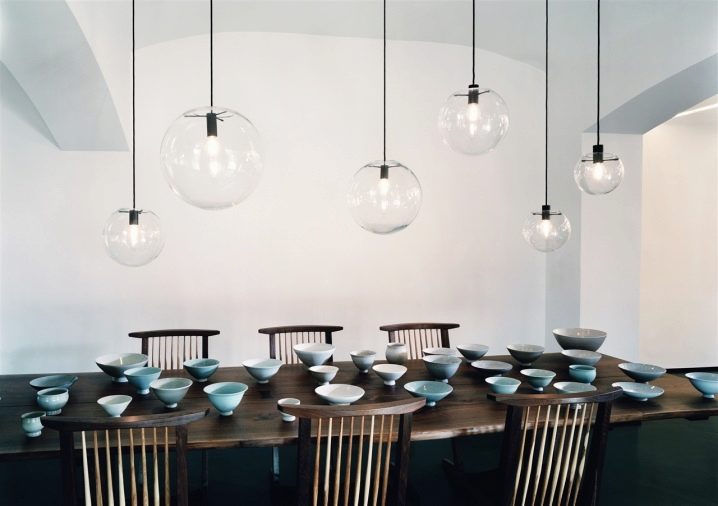
How and where to place
To make the ceiling beautiful and spectacular, you first need to draw up a project for the placement of lamps.
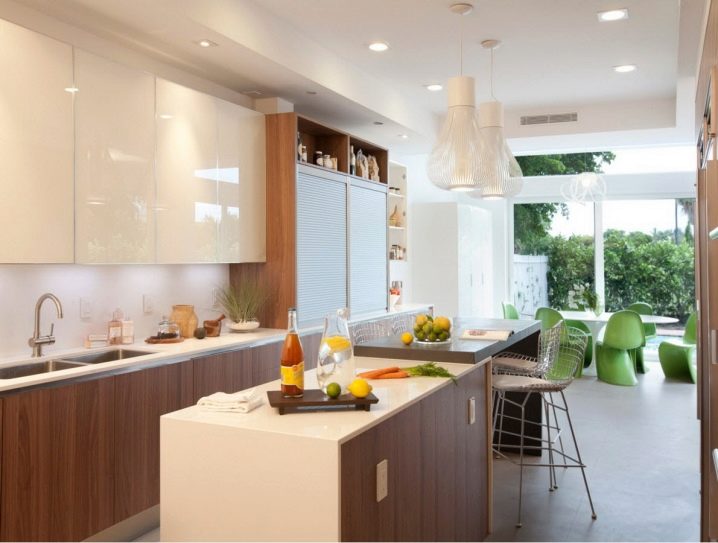
In this case, it is necessary to take into account:
- the geometric shape of the kitchen;
- parameters of its natural illumination and darkness;
- whether space zoning is planned;
- will there be a chandelier in the kitchen, or only lamps.
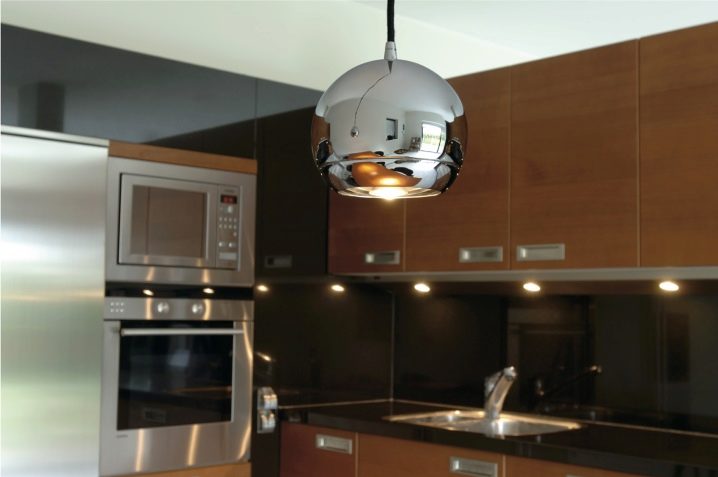
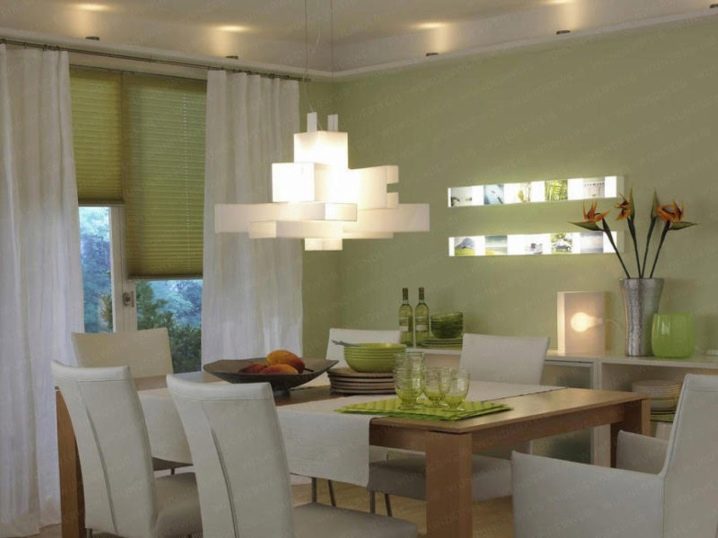
How to decorate
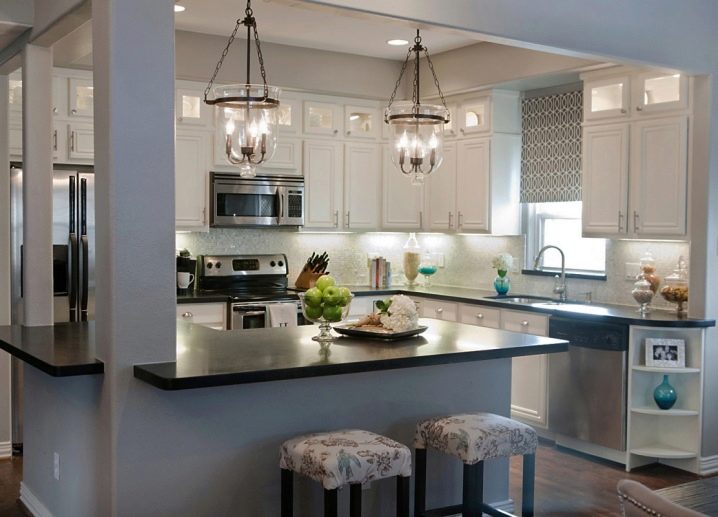
Chandeliers are different. Here you can turn on your imagination and play with both color solutions, and with the form, and with the material. The main thing is that the chandelier should be made in the same style as the kitchen in general. An example for decorating a hanging chandelier can be a Soviet porcelain lampshade, which will look great in an interior made in the style of the 80s. (0)
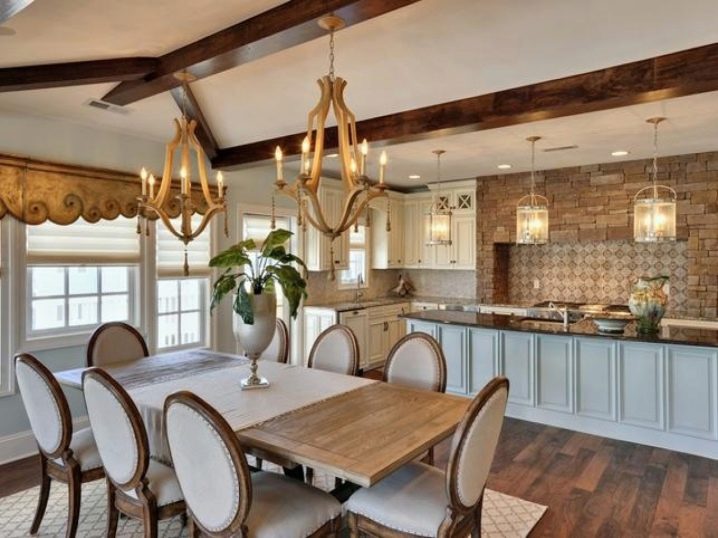
Overhead lamps can also be interestingly decorated, glass shades will look great on the kitchen ceiling.
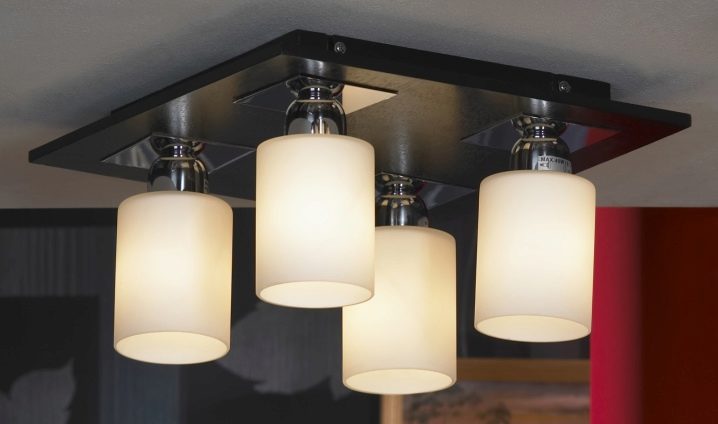
The choice of interesting stylistic solutions is very large, and in this set everyone can find a suitable option for themselves.
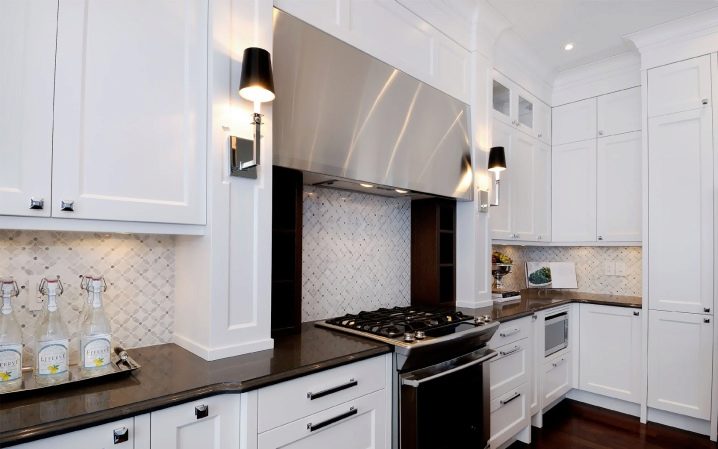
Here are some interesting solutions selection of fixtures for the kitchen ceiling
- lampshade from copper wire, resembling a wicker basket on an overhead lamp in the work area, is perfect for decorating a rustic-style ceiling.
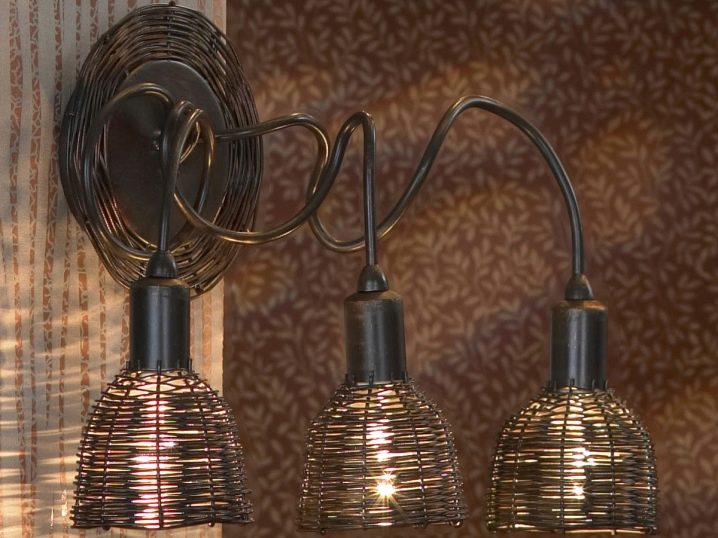
- A bright accent on the ceiling will help turn the hospitality look of a white kitchen into a stylish design project.
How to organize kitchen lighting, the most common mistakes lights in the kitchen, how to choose the right fixtures and save on electricity - in this article.
The main secret of good kitchen lighting is multi-level. Each functional area - where you wash dishes, cut food, eat food - should have its own light sources. Let's figure out which ones.
General kitchen lighting
Can't do without. Its task is to maintain comfortable illumination in the dark.
Error 1: Plan your lighting ahead of your kitchen design project.
Solution: What exactly will be the lighting of your kitchen, you need to determine before the start of the repair. But only after you have decided on the layout of the kitchen and decided where the main functional areas will be located - the sink, stove, worktop and dining table. Then you can place the lights in the best possible way, exactly where they are needed. And you definitely will not forget to lay electrical outlets for appliances and lights, sockets and switches in all the right places.
Error 2: One lamp in the center of the ceiling
Solution: General kitchen lighting with ceiling lights (one or more) and local lighting of functional areas.
The pendant lamp in the center of the ceiling has several drawbacks at once.
When you are doing cooking, for example, cutting vegetables on the work surface of the kitchen set, you stand with your back to the light source. As a result, the countertop is in the shade.
In addition, there is almost always free space in the center of the kitchen. As a result, the lamp does not illuminate anything useful, and the really important areas are in darkened corners.
Error 3: There is no way to adjust the brightness of the general lighting.
Solution: install a switch with a dimmer (rheostat). It allows you to change the brightness of the general kitchen lighting depending on your mood. During a family dinner, when you want to relax and unwind, the light will be more cozy and subdued. And while cooking, it can be made brighter.
Advice: when buying a dimmer, do not save. A cheap switch can fail quickly.
5 options for ceiling lighting for the kitchen
The main lighting should be even and as neutral as possible. Each of these options can be used individually (especially if the kitchen is small) or in combination with each other.
So, what is most often used for basic kitchen lighting?
1. Recessed spotlights
2. Overhead lights
3. LED backlight
4. Tire lights
5. Chandelier or pendant lamp
An important point - when planning lighting in the kitchen, make sure that the general lighting can be turned on in parts, and not all at once. This is not only convenient, but also practical: it allows you to turn on exactly as much light as you need, which means saving energy.
Issue price
Many designers and craftsmen note that lighting accounts for approximately 10-15% of the budget allocated for kitchen renovation. Half of this money will be needed for the purchase of the fixtures and switches themselves, the rest for the installation, if you do not plan to mount the kitchen lighting yourself.
designer advice
To illuminate the kitchen, you should choose lamps that give a neutral white or warm light. That is why cheap fluorescent lamps for the kitchen are not suitable. Most often, they shine with a bright, but lifeless bluish light. Such lighting causes a subconscious feeling of anxiety and spoils the appearance of food. Worse for the kitchen you can not imagine.
Color temperature is denoted by special units, kelvins, and is indicated on the packaging of the light bulb. Need a warm light? The box should have a number from 2700 to 3300 kelvins. Look for a light bulb with a neutral white light in the range from 3300 to 5300 kelvins.
It is good if the Energy Star energy efficiency standard is also indicated on the box. Lamps labeled A and B are more expensive, but consume much less electricity, helping you save your family budget.
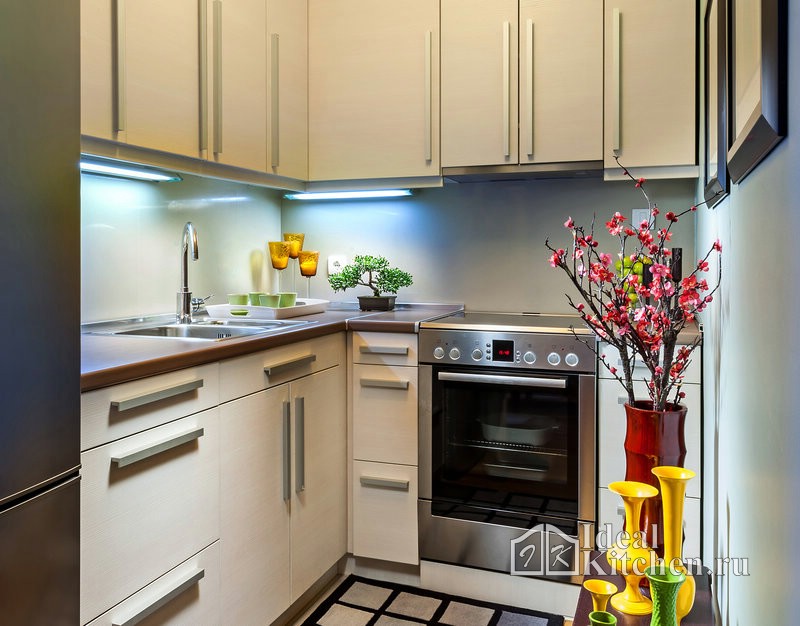
4 secrets of lighting the working area in the kitchen
The countertop on which you cook food requires the best lighting. That is why a modern headset cannot be imagined without local illumination of the working area.
If you are making a kitchen to order, the manufacturer of the headset will surely offer you their own version of lighting the kitchen countertop. However, most furniture companies make a big markup on accessories, such as lighting or household appliances. Therefore, if you want to save money, it is better to purchase the backlight yourself.
So, what lighting options are best suited for this purpose.
- Pay attention to overhead furniture lamps - halogen, fluorescent and LED. They are specially designed for mounting on the bottom of wall-mounted kitchen cabinets. Such lamps perfectly cope with their main task - they provide directional lighting and make your work in the kitchen convenient and safe.
The market has the most different variants such illumination. Most often, these are round spotlights with a metal case or elongated lamps with a protective plastic case. Such a case not only protects the lamps from moisture, steam and grease. It also does a great job of hiding technical details and wires. The result - the kitchen always looks neat. - Round and elongated furniture lamps have more interesting alternatives from a design point of view. For example, LED Strip Light RGB in aluminum or plastic profile. In addition to working white lighting with its help, you will get spectacular countertop lighting in the most incredible colors. You can control it with a remote control or a switch.
- Glowing from the inside, open shelves made of tempered glass or a glass bottom panel of hanging cabinets are an equally original solution for local illumination in the working area of the kitchen.
- Another non-banal lighting option - glass apron with built-in LED lighting.
When planning the lighting of the work area of the headset, do not forget about the number of sockets sufficient for your needs! Where they are most important, our infographic will tell you:
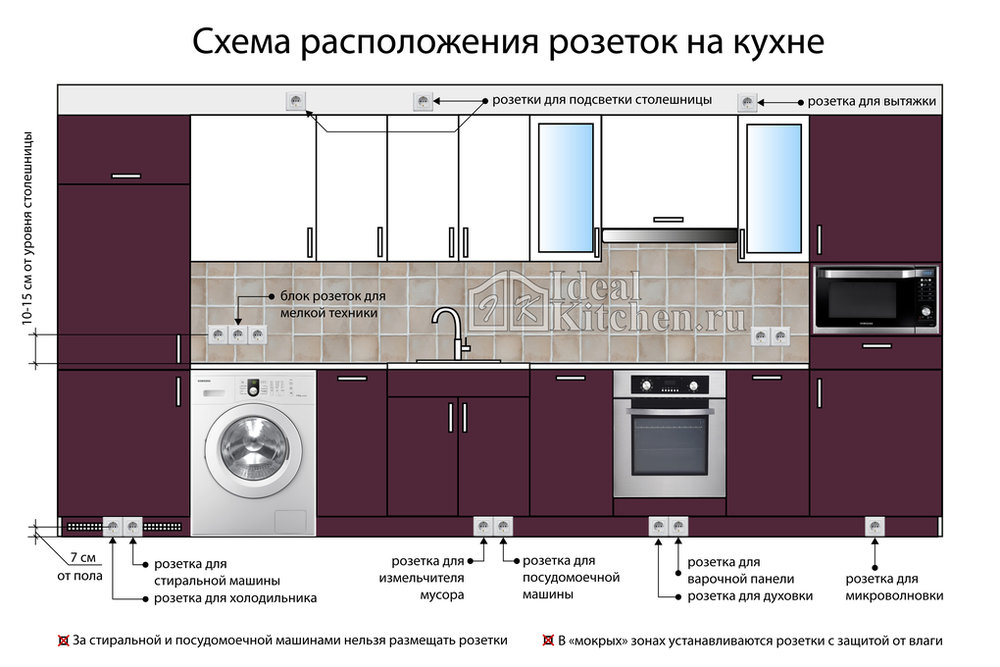
The brightness of the light in the working area can also be adjusted using a dimmer if desired. However, most often this is not necessary.
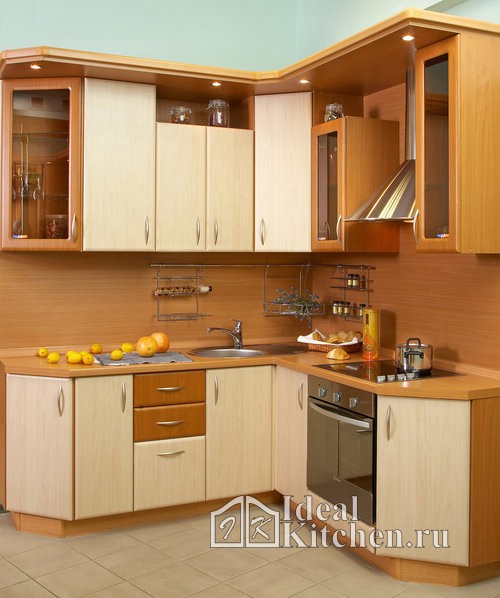
AT recent times major manufacturers kitchen lighting are increasingly relying on LED lights. They have a very weighty plus - excellent energy efficiency. quality LED lamp it shines brightly, consumes much less energy (savings can reach 85%), and it lasts 20 times more than a conventional lamp. But such lamps are more expensive than halogen or fluorescent kitchen lighting.
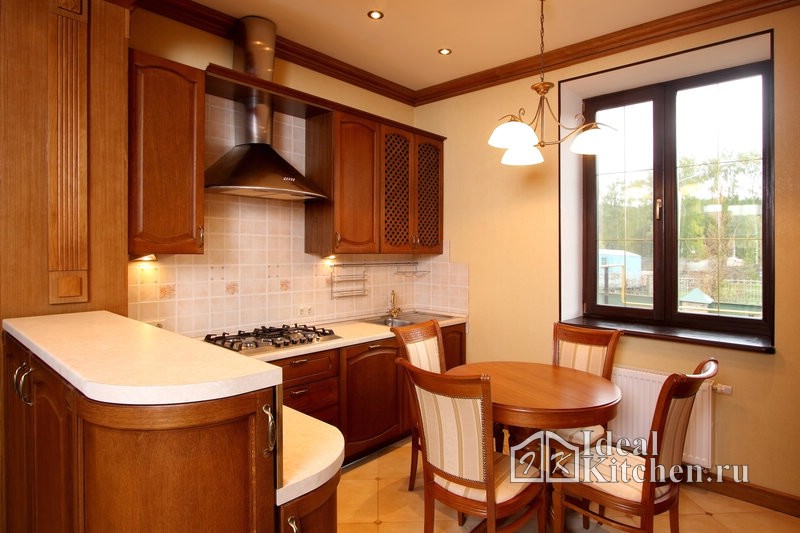
Dining Table Lighting - 6 Popular Options
If the kitchen also serves as a dining room, you should separately take care that the dining table is always adequately lit. This goal can be achieved in different ways.
1. The most popular solution is a large pendant lamp with a beautiful shade or lampshade, located above the center of the tabletop. Ideally, if the length of the suspension of the selected lamp can be adjusted.
The optimal height from the bulb to the surface is approximately 1.5 meters. If you raise the lamp higher, the lighting of the dining area will be brighter and more solemn. If you omit it - more intimate, homely and cozy.
It is important that the light does not hit the eyes of those sitting at the table. It is worth giving preference to models of lamps with translucent shades of frosted glass. They gently diffuse the light.
When choosing a lamp, pay special attention to the material of the lampshade. You should not buy a suspension or chandelier with a fabric lampshade. No matter how good the hood is, it gets dirty faster and is difficult to clean. A glass or plastic cover is much more practical.
2. If you don't like big light, a good choice- several graceful suspensions with small shades. Most often for the dinner table standard sizes 2-3 such lamps are quite enough. They can be hung in one group or distributed along the central axis of the table at an equal distance from each other.
If the table is round or square, one lamp in the center of the tabletop is often sufficient. If you have chosen an oval or rectangular model, bar table or bar counter - buy two or three pendants that will evenly illuminate the dining area
3. If the dining table is close to the wall, sconces or spots can be used as local lighting, the luminous flux of which is directed downwards. However, this option loses in comparison with a pendant lamp in several directions at once. The suspension illuminates the entire surface of the table much more evenly. The wall lamp will leave part of the countertop in the shade. In addition, the sconce will not be appropriate in every style of interior. In addition, it scatters light more, and the illumination of the table may be insufficient.
4. A rail system with lights above the dining table can also be a good lighting option for a modern kitchen.
5. If you plan to light the dining area in big kitchen or a kitchen combined with a living room, above the dining table, you can make a suspended plasterboard structure with built-in spotlights. In this case, it will serve as an additional element of space zoning.
6. Furniture lamps above the dining table can be built not into drywall, but into a furniture canopy made of laminated MDF or chipboard.
Interior lighting for kitchen cabinets
Worth lighting up wall cabinets or headset drawers from the inside, and it will be much more convenient to use them. It looks very nice in combination with frosted or stained glass facades.
LED lights - the best solution for lighting kitchen furniture: it does not heat up, so it is completely safe to use, and consumes very little electricity.
By the way, such lighting can work constantly or turn on only when the drawers are pulled out.
Stove or hob lighting
The best option is a backlight built into the hood casing. However, special illumination of the hob is rarely needed. As a rule, the general lighting is enough for the hostess to look after the pots.
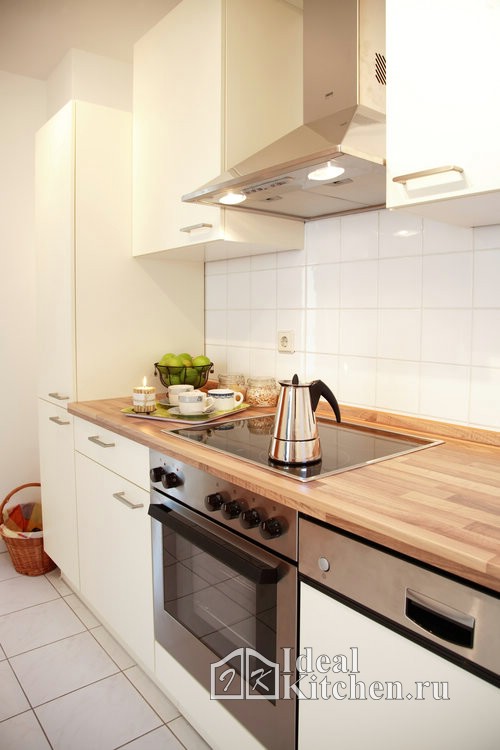
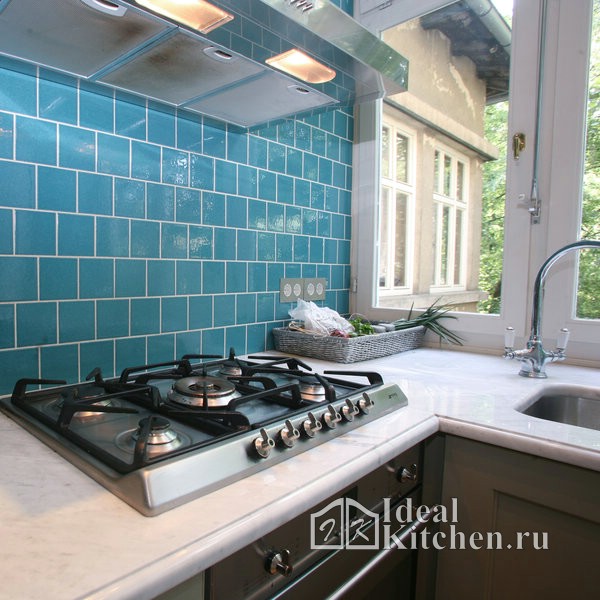
Spot lighting (including in the kitchen) is one of the main current trends in the arrangement of houses and apartments. A lot of time is always given to the selection and installation of lighting devices. After all, everyone wants their home to be not gloomy and uncomfortable.
The kitchen is a place where an abundance of light is very important. But at the same time, large chandeliers in this room are useless. Spotlights are an excellent solution for lighting in the kitchen. Their placement, if necessary, will illuminate every corner of the room. At the same time, spotlights are unique design decision, which is suitable for almost any style, especially modern.
![]()
Advantages of spot lighting
Before equipping the kitchen with spotlights, you should familiarize yourself with all the subtleties, advantages and disadvantages. This method of lighting is popular for the following reasons:
- A wide range of. Spotlights are varied. When choosing colors, shapes and sizes, the eyes just run up. Undoubtedly, this is a big plus, because you can use them in absolutely any design. But this factor has another side of the coin. With a large assortment, there is a high probability of making the wrong choice. Therefore, it is worth carefully evaluating each model.
- Elegance and beauty. Due to its compactness and attractive appearance spotlights placed in the kitchen will add charm to the room.
- Can be installed on any surface. Luminaires can be easily installed on both conventional and stretch ceiling. In addition, they can be attached to walls and even to kitchen hanging cabinets.
- Profitability. Due to their small size, even in large quantities, they consume minimal energy. To reduce the cost of paying bills, you can install several switches to the lamps. Thus, if necessary, it is possible to illuminate one specific area.
- Functionality. Devices can serve as an addition to the main light source, or they can completely replace it.
Advice ! To minimize energy consumption, care should be taken to have a special dimmer (dimmer).
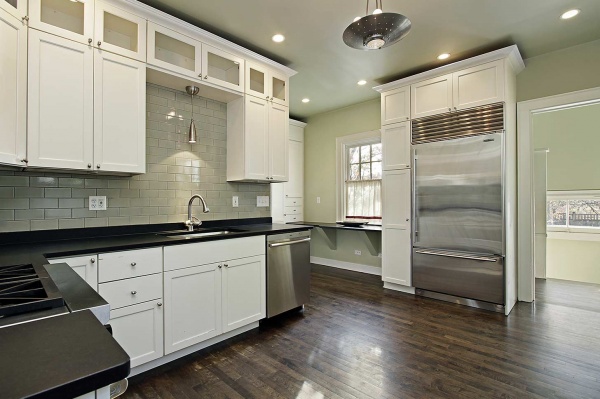
Disadvantages of spot lighting
Like all interior items, spotlights, despite a sufficient number of positive aspects, have their drawbacks. The disadvantages of these lamps are not so significant, but still you should not forget about them.
- Their installation is a more painstaking task and requires more time, unlike conventional pendant lamps.
- If you want to place such fixtures on the ceiling, you should take care of installing them even at the repair stage. If desired, mount them in kitchen set, you should take this into account at the stage of its assembly.
- Also, the installation of spotlights in your own kitchen may be hampered by prevailing stereotypes. Many people think that such lamps serve as lighting for offices. However, you can easily get rid of such thoughts by looking at a photo of a kitchen with spot lighting. It will immediately become clear that such lamps are in perfect harmony in any room.
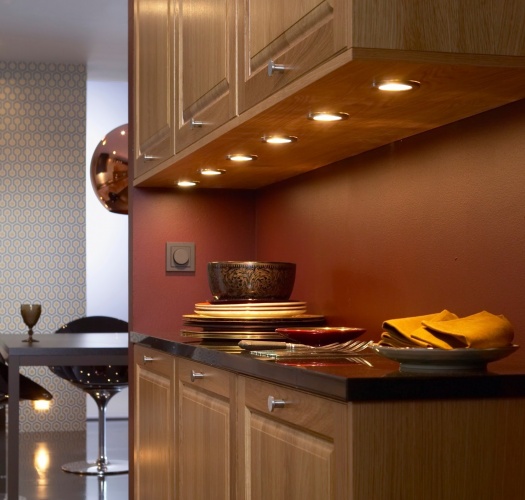
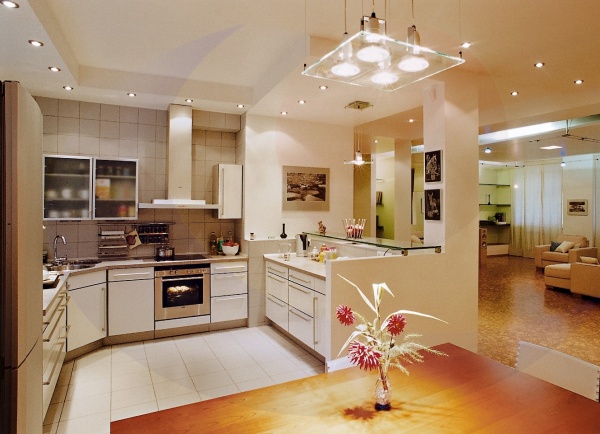
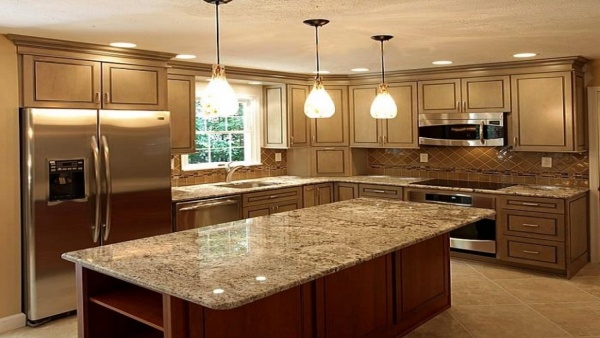
Design
According to their design, these lamps are divided into two types:
- Directional lamps. They are able to illuminate the room in only one direction, which is determined from the very beginning.
- Rotary light sources. Such lamps are more functional, as they can rotate around their axis by 40 degrees. This option is especially popular for installation in the kitchen and headsets, in particular. Indeed, in this case, during operation, you can direct the light in the right direction.
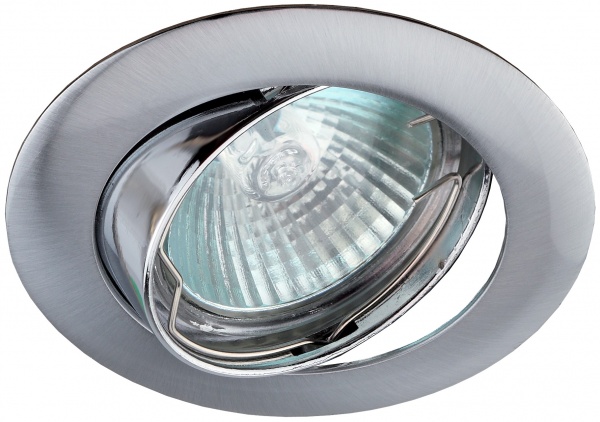
Types of spot lighting
Everything is clear with the design, but this is not the only difference. Spotlights also differ in the installation method. There are recessed, suspended and overhead lamps. The first option is the most popular for the home. The main advantage of such lamps is that when they are turned off they are almost imperceptible. In addition, their design is quite diverse. The disadvantage is that built-in lights are installed only on false ceilings (stretch, plasterboard and others).
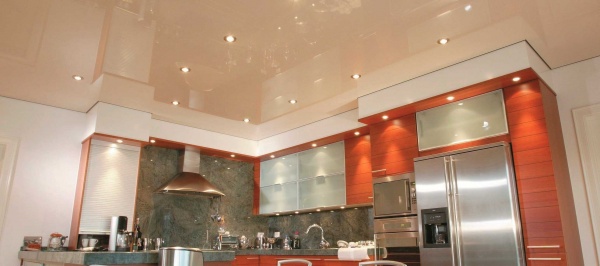
For ordinary concrete ceilings in the kitchen, it is recommended to install overhead spotlights. Unlike the previous version, they are freely attached to any ceiling. However, many are confused by the fact that they are quite noticeable. But if you wish, you can choose a lamp with various decorated inserts. Such a lamp is attached thanks to a special spot, which is installed on its base.
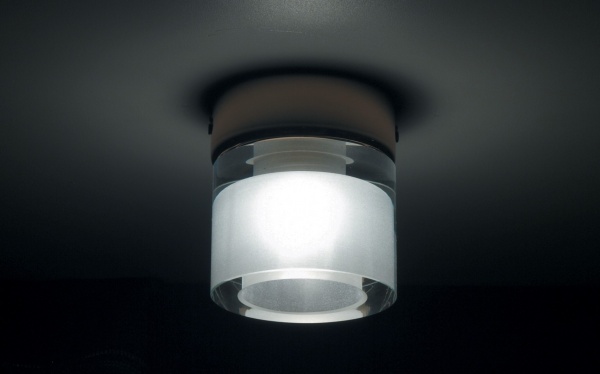
Both mortise and overhead fixtures have design advantages. The first one is almost invisible. This will create an unusual atmosphere in the room. Overhead lamps can be decorated with various bright light diffusers, which will also give the room a unique look. In addition, such lamps have a wider angle of illumination.
Important ! Before installing fixtures, it should be borne in mind that each individual device is able to illuminate no more than 2 square meters.
The choice of lamps for the lamp
In addition to the design and design, it is worth deciding which lamps the lamp will be equipped with. For spotlights, conventional incandescent or halogen lamps are used. The main difference is that with equal power, the first option emits slightly less light. Therefore, to illuminate the same area of the room, lamps with incandescent lamps will need more
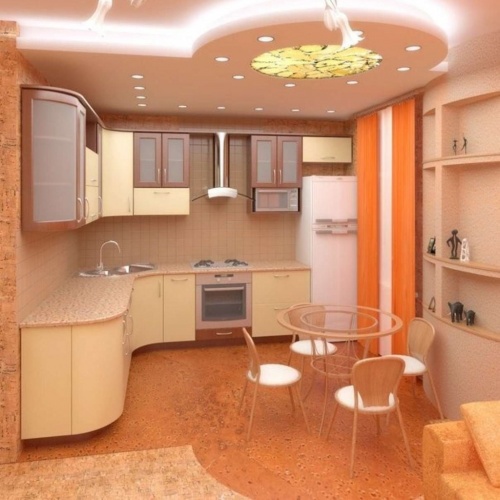
What to look for before buying
The choice of spotlights should be approached wisely. If there is no experience in acquiring them, it is better to consult a specialist. So, before purchasing, you should pay attention to the following parameters:
- Producing country. Despite the prevailing stereotypes, you should not immediately cut off the products of Chinese manufacturers. Of course, most of them are of low quality, but you can find those that are no worse than European brands in terms of characteristics and cost at the same time will be somewhat cheaper. Usually on such goods it is written by Europe. But besides Chinese lamps, the market is rich in both European and domestic goods.
- Quality . As mentioned above, it will be difficult for an inexperienced person to choose a truly high-quality product. And the rule "the more expensive the better" is not always appropriate.
- Colors and shades. Often you can buy lamps from the same batch, but their shades will differ. If they are placed close to each other, it will immediately catch the eye. If such a situation does not cause any embarrassment, you can safely take the lamps from the photo or by looking at only one of all. The rest, if possible, is recommended to inspect each spotlight.
Advice ! Design is also important. It is worth considering that the light sources will be placed in the kitchen. Therefore, grease stains and other contaminants cannot be avoided even by the most accurate cooks.
Therefore, the design of lamps should not include complex decorative elements, since it will be difficult to wash them. Better simple, but tasteful.
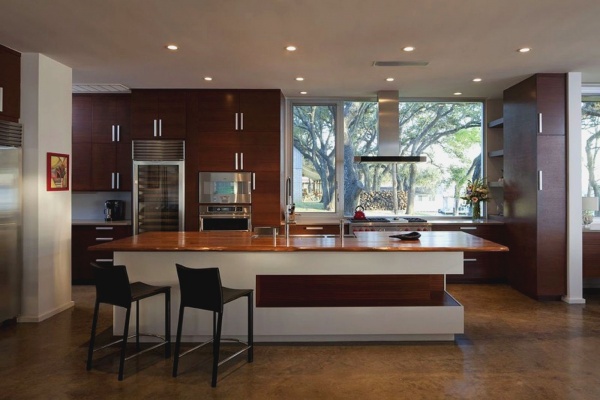
Accommodation in the kitchen
The location of spotlights in the kitchen depends mainly on individual preferences. But there are still some recommendations. The main thing for the kitchen is convenience and functionality. Lighting must also comply with the rules.
The most important thing is to provide light to the two most necessary zones. The first is the one in which the cooking process takes place. The second is the dining area itself.
Also, it will not be superfluous to install the ability to adjust the level of lighting. That is, if necessary, turn on the light only in the working or dining area, and so on.
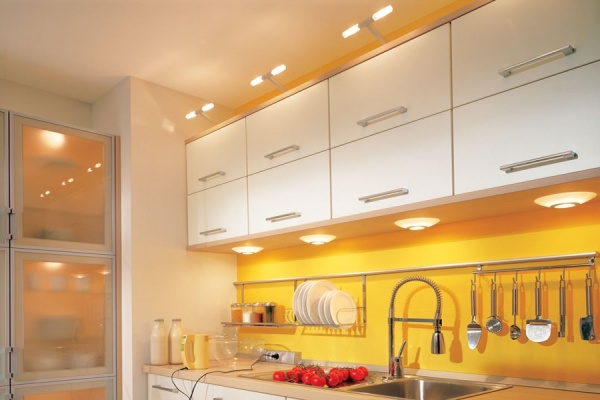
Work area lighting
To ensure maximum comfort when working in the kitchen, it is better to take care of the presence of additional lighting for important work areas. It is even better if the lamps are with the ability to change the angle of illumination (swivel). You can see examples of the location of spotlights for work areas in the kitchen in the following photos.
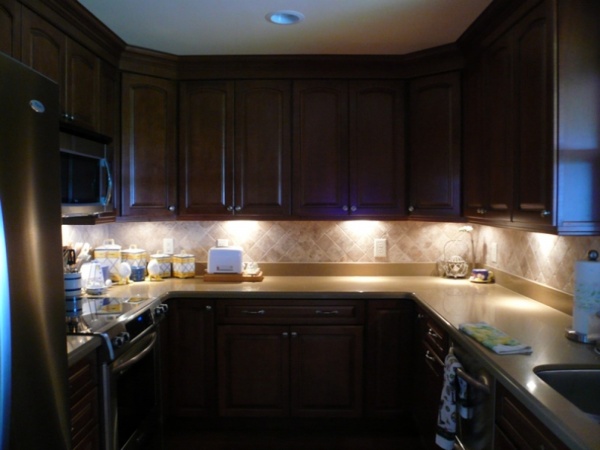

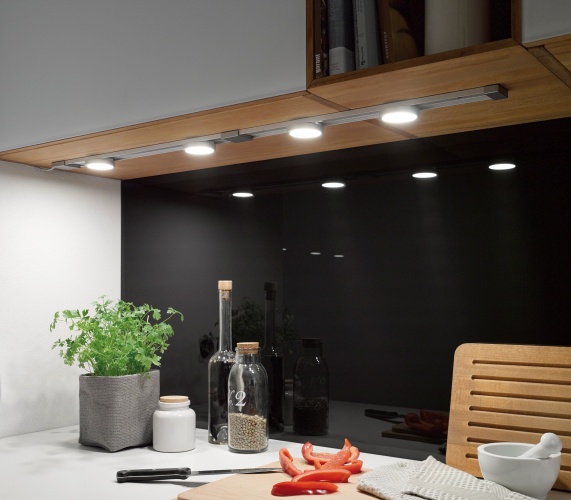
This lighting method will justify all efforts and expectations. The room will be bright, stylish and modern. It will be useful for everyone who is interested in arranging their own kitchen with spot lighting to watch the following video.




















